Sunday, September 27, 2009 03:25 pm
News Flash from Iran
In case you missed the news from Iran ...
A few facts are now in concerning the crash at the 2009 Sacred Defense
Air Show (WTF?) in Tehran.
On the 22nd of September, at 09:02 hours, IRIAF IL-76MD "Simorgh"
(Baghdad-2/Adnan-2, No. 1 with 5-8208 serial) crashed near Varamin City,
killing all seven crew members aboard. At 09:02 hrs, the pilot radioed to
Mehrabad control tower that the aircraft's engines under the right wing had
caught fire.
The tower signaled the aircraft to attempt an emergency landing on runway 29
Left. Upon final approach, due to the aircraft's undesirable angle of attack,
the over-fuselage rotor dome detached and collided with the vertical tail
sections. After that, the aircraft suffered a catastrophic crash.
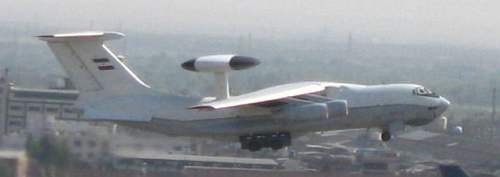
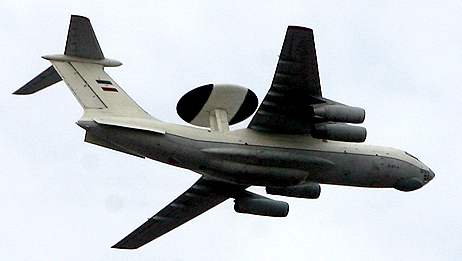
The crash occurred the day before Whack-A-Dina-Job left Iran to attend the
meetings at the UN. He didn't say anything about the disaster in his speeches.
It was the only AWACS-type aircraft that Iran had .. and came into their hands
way back before the first Gulf War, courtesy of Saddam Hussein who had most of
his air force flown to Iran for 'safe keeping'. Iran subsequently decided to
keep them and turned the Russian-built C‑141 design ripoff into its only AWACS
model. It collided with a US-built F5 during the airshow.
Proving that old saying: "Allah Akbar", the IL-76 aircraft is reported to have
landed on the site of the tomb of former Iranian leader Ayatollah Khomeini!
Really.
A "Simorgh" is a "fabulous, benevolent, mythical flying creature" of Persian
fable.
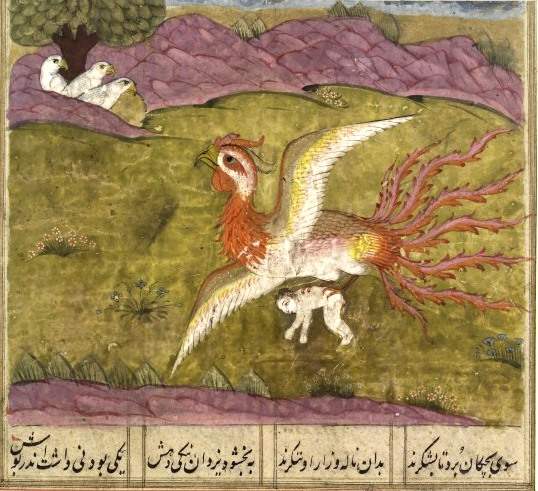
This
WIKIPEDIA link has details on
the crash.
Here's a link to a good shot
of
the aircraft that was involved in the crash. As of 9/27/2009 there have
been 59
major (complete hull loss) accidents involving the IL-76.
It was probably one of the F5s shown IL-76
in the photo at this
Airliners.net link that collided with the IL-76.
You can see video of the crash here:
.
Sunday, September 27, 2009 03:22 pm
For You Stamp Collectors
From eBay:
Sunday, September 20, 2009 03:30 pm
Detective Work Needed
Remember that crazy whacko, Mir Aimal Kasi, who killed two folks outside of CIA
headquarters back in 1993? (See
WikiPedia
for details if you need a refresher.
A couple of days after his capture in Pakistan in 1997 he was put on a C‑141
and shipped back for trial where he was found guilty and executed in 2002.
A little bit of Googlin' turned up the fact that he was spirited out of
Pakistan on a C‑141, after being 'rendered' by some special ops guys. They
dashed to the local airport and were being chased out of town by the local
'authorities'.
He was then routed back to he US via Ramstein, where he shared a nice first
class seat on a C‑141 with some other prisoners. Supposedly he confessed while
on the flight back to the US (after being read his Miranda rights, of course).
So the question posed is : Does anybody know what tail number he was on, either
out of Pakistan or on the trip from Ramstein to the US?
No names will be posted.
Sunday, September 20, 2009 02:48 pm
Two New TALL-TALES
Tim Louden has submitted two new T-Tail-Tall-Tales
Hey, Hey! You, You! Get Offa' of My Cloud!!!
Ailing_Aileron_Airways
Saturday, September 12, 2009 05:34 pm
More Details on destruction of 66‑0253
Joshusa Potts sent in a detailed description of what went wrong when
66‑0253 burned up at Travis back in 1993.
.
You'll have to scroll towards the bottom of screen to read it.

What was left of it....
Saturday, September 12, 2009 05:15 pm
That C‑141 Just Gets Under Your Skin.
We try to stay away from too much skin on this site, but Tim Louden has gone
above and beyond the call of duty with this one... his note:
I was in from 1974-1994. I was very proud to have been Crew Chief of
C‑141
tail number........"141!" How proud? Take a look.
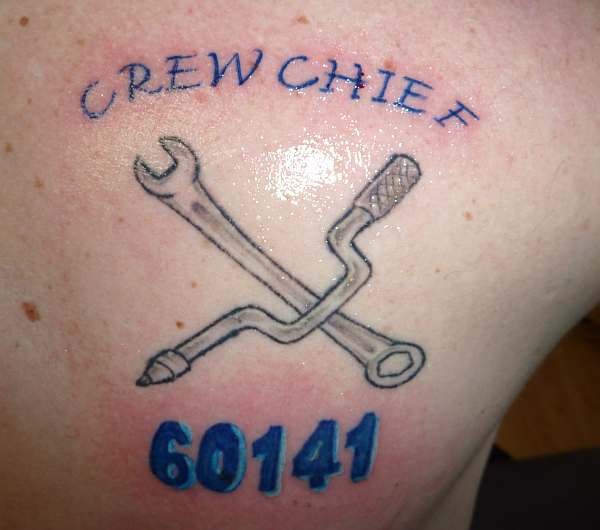
Thimsen R. Louden TSgt
USAF (Ret)
Saturday, September 12, 2009 04:58 pm
Nice Art ..
Chart Art
The Tumwater, Washington, company sells (mostly Navy and Coast Guard) oriented
artwork
superimposed on nautical and aeronautical charts. They have at least one C‑141
piece. They all seem to cost $40-$200+, framed, depending on the size.
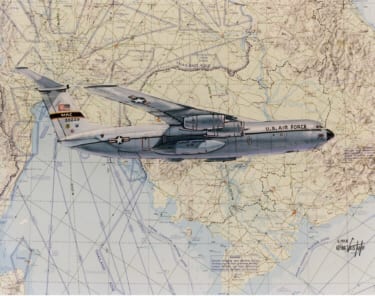
Saturday, August 8, 2009 05:03 pm
Sorry for the absence!
Hi everyone. I've finally gotten back into the swing of things. After my
vacation in mid-June I just had so many things piled up I did not have time to
spend on C141heaven. And when I got back to it...I found I could not upload
files to the site by FTP. So it's been a bit of a hassle but all seems back on
track.
The items below are presented in no particular order ... just a lot of things
that have come my way via email and web browsing for the good old C- 141!.
Don't know if any of you saw the news on Military.com last week, but the AF
finally retired the Cessna T-37! Almost every AF pilot for the last 30 years or
so (something like 78,000 of them) flew it. Now it's up to one of you to start
of Tweet Site (and I don't mean Twitter)
Saturday, August 8, 2009 05:08 pm
You Bought A Leading Edge What @#$^#^%!??
A few days ago I came across this set of photos.... looks like some
lucky(?) guy in the LA area got a deal on some surplus that had been sitting in
a warehouse (maybe at the old Norton or from March AFB?). It looks like his
yard is full of all sorts of 'man-stuff', including a FORK LIFT to move it all
around.
I'm guessing his wife probably told him (based on the date on the photos vs.
the date the item was posted on eBay ) "That s**t's gotta go, NOW! Mom's movin'
her trailer onto that spot next week!".
The "item" was priced at $1,500.00, so I'm guessing it didn't sell. Maybe you
can locate it at the landfill (or perhaps up the poor guys ass). Women just
don't get it.
Sunday, August 9, 2009 07:14 am
New C141 Book ...
John Burford, a long time visitor to C141Heaven, has published a book you might
be interested in. There's lots of 'never before seen' photos of the C‑141 in
it. "C‑141 Starlifter in Action - Aircraft Color Series No. 215"
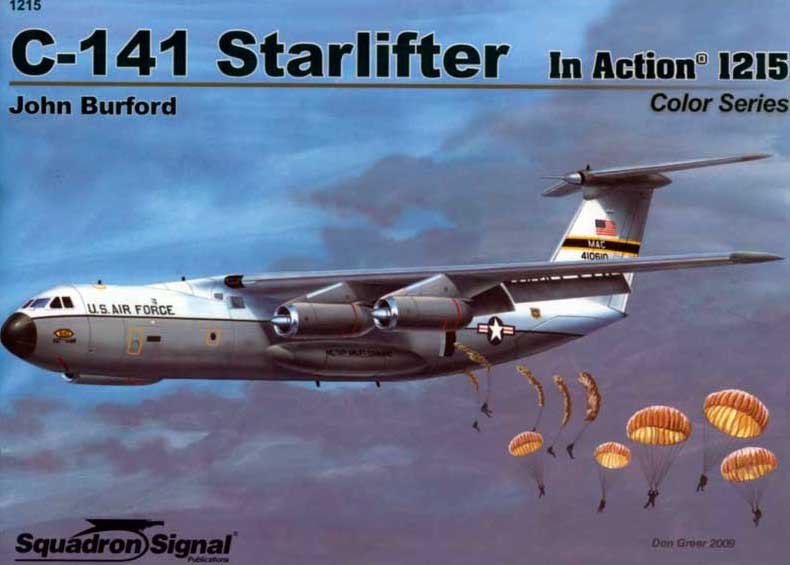
It's available on
Amazon.
Saturday, August 8, 2009 06:03 pm
Sapper Attack ... Udorn Royal Thai AFB --26 July 1968
Got this from David Ames quite a while ago...
Sapper Attack 26 July 1968 The first attack on a U.S. Air Force Base
in
Thailand took place Friday evening, July 26, 1968 at Udorn Royal Thai
Air
Force Base. Security was routine except for precautionary support of a
C‑141 medical transport standing by for possible evacuation of three
prisoners of war who had been released by Hanoi. Security for the
aircraft
included placing a sentry team close-in and a quick reaction team
nearby.
At 10:25 pm, approximately 25 attackers from four locations opened
fire
with automatic weapons against the northwest corner of the base.
It appears that this attack was a diversion because at the same time
several sappers attempted to reach the C‑141. The close-in guard
killed one
sapper under the tail of the aircraft and another sapper 20 yards
away. A
third intruder fired his AK-47 rifle into the area around the C‑141,
which
appears to have caused a fuel leak from one of the aircraft's engines.
The
sapper then threw an explosive charge under the aircraft and another
under
a mobile power unit. The first charge ignited fuel that was pouring
from
the damaged engine. The sapper then ran down the length of the taxiway
toward two F-4D aircraft. These aircraft were undergoing maintenance
and
did not have any special security. The sapper threw an explosive
charge
into the back of a Security Police truck and another into the tailpipe
of
an F-4. The charge in the F-4 failed to detonate; the sapper turned
and
placed another. The second charge detonated; the sapper then ran into
the
grass and escaped.
An HH-43 helicopter equipped for fire suppression and ground
firefighting
units were able to stop the C‑141 fire, but the HH-43 was damaged by
small
arms fire. Quick-reaction forces responded within 2 minutes of the
original
attack and engaged the remaining attackers with small arms fire. The
attackers then retreated. The attack caused heavy damage to the C‑141,
moderate damage to the F-4, and light damage to the HH-43. Light
damage was
done to four USAF vehicles, a power unit and a light unit.
TSgt, Paul Yonkie, flight engineer of the C‑141, was seriously wounded
and
died of his wounds at Clark AB in the Philippines 9 September 1968.
Yonkie,
from Ridgeway, Pennsylvania is remembered at Scott Air Force Base as
"C"
Street was renamed Yonkie Drive.
Capt. Lawrence L. McCracken wrote this account with interviews with
the
C‑141 crew. The article was presented to Udorn Research Group by
member,
Don A. Bailey, an Udorn veteran from Westminster, Colorado.
We Were Sitting Ducks To Red's Bullets
(Special) Oh, hell, Not in Thailand. This is an R & R place. Sgt.
John
T. Walsh thought as the red tracer bullet zipped over his head.
Startled
into action, the medical technician dropped his cigarette and ran to
the
nearby light cart. I yelled over my shoulder to the security guard I
had
been having a smoke with, Set your
M-16 on automatic! Sgt Walsh recalls.
There was only one light cart illuminating our C‑141. The lights,
though,
were shining on the forward crew door of the aircraft. We were sitting
ducks on a pond---unless I could get those spotlights turned away from
the
plane.
Thus begins the first attack by Communist terrorists on Udorn Royal
Thai
AFB, Thailand. The date is July 26, 1968. It is 10:30 p.m. Caught in
the
middle bathed by two mercury lightsis a Military Airlift Command C‑141
on a
special aero medical evacuation mission. The flight and medical crews,
with
exception of Walsh, are inside the parked Starlifter trying to catch a
few
hours sleep.
The five medical crew members are assigned to the 56th Aeromedical
Evac.
Sq. Yokota AB, Japan Two of the flight nurses recall those first few
moments which are permanently etched on their memories.
All the electrical wires in the fuselage were shorting out arcing from
one
to another. The noise woke me up, said Maj. Louise Stroup. Someone
yelled
something about fire, so I ran towards the forward crew door, the only
one
open.
Going down the steps I saw the outboard engine burning. At this time I
didn't realize we were under fire. Continued the major from Las Vegas,
Nevada. My first thought was to get away from the C‑141 before it blew
up.
I started running and then all these tracer bullets started racing by.
Maj. Monna L. Mumper, of Chambersburg, Pennsylvania remembers, I was
sleeping across the reclining seats, with the armrests removed, in the
back
of the plane. Someones shouting, Fire! woke me up. I grabbed my shoes
and
ran to the front of the plane.
The C‑141, with three pickup trucks, a light cart and an auxiliary
power
unit around it, was parked at the far end of Udorn's taxiway 4. The
Communist terrorists were attacking from a 20- foot high ridge about
300
yards to the rear and left of the plane.
Walsh, of Hartsdale, New York, and a security police guard who Walsh
only
knows as Sergeant Johnson offered the first resistance to the enemy. I
was
able to turn the two spotlights off the plane and play them up on the
hill.
Walsh explained. I could see the enemy real well. They were clustered
in
groups. Some of them were picking up the wounded that Johnson had
nailed.
Then I rushed back to the light cart, Walsh continued. Johnson was
still
firing his M-16 but he had taken a grenade fragment in the leg. We
started
to retreat around the front of the plane.
By now the crew was running from the aircraft and looking for cover.
The
three pickup trucks were already in flames. The pilot and flight
engineer
were huddled behind the auxiliary power unit when it was hit. The
pilots
hands were badly injured and the engineer received back wounds.
Despite
their injuries, these two made it to the grass at the far side of the
taxiway.
As I was running toward the grass one of the jet engines caught fire
again.
The engineer stood up to either look or run. I yelled, Get down! but
it was
too late. He took one in the stomach. Walsh recalls grimly. When I got
to
the pilot his hands were bleeding badly. I tied one of my shoelaces
around
one wrist and wrapped his t-shirt around the other forming makeshift
tourniquets.
I had an empty feeling out there. I felt so useless. I had two wounded
men
around me and didn't have anything to defend us with. We had to just
watch
those people out there running around and wait to get shot at. Maj.
Shroup
also ended up in the grass alongside the taxiway. As I ran across the
concrete some security police in the grass yelled. Get down!
One of them shouted, Hold your fire! I guess Maj. Mumper and I were in
their crossfire. But I was frightened of the plane blowing up. Maj.
Stroup
continued. I looked over my shoulder and didn't think I was far enough
away
from the burning plane. So I kept on running. But when they yelled the
second time, I thought Id better obey. I ran off into the grass and
dropped
to the ground.
I was glad they were shooting tracers because you could see the
bullets
flying over your head you almost had to stay down. I laid right down
on the
taxiway. By this time, security vehicles and fire trucks were all over
the
place. I was more afraid of being run over than shot.
I heard some shuffling feet, she said. Someone was approaching me, but
I
was facing in the opposite direction. I didn't realize it was a
Communist
terrorist until he had gone past. He was so close I could have reached
out
and touched him but I didn't. I didn't move a bit. Tracers were still
coming,
just a matter of a few feet overhead. Skinny as I am, I thought I was
awful
big lying out there on that ramp. I said prayers I hadn't said in
years.
It was more than 45 minutes before the two nurses were able to catch a jeep back to the
dispensary. They found Walsh already there with the two wounded crew members. It was a
long night for the weary medical crew. They departed the base for a downtown hotel at 5
a.m. Flares were still being dropped as security forces continued to root out the enemy.
The wounded flight crew members were flown to Clark AB, in the Philippines, the afternoon
following the attack. The flight engineer died several weeks later from his wounds.
Prisoner Release
In a blatant propaganda scheme, Hanoi announced July 3, 1968 that
three
American prisoners of war would be released. The trio would be
released to
Stewart Meacham (Philadelphia), Peace Secretary of the American
Friends
Service Committee; Mrs. Anne Scheer of Berkeley, California, wife of
Robert
Scheer an editor of Ramparts Magazine; and Vernon Grizzard, an anti-
draft
organizer from Cambridge, Massachusetts.
The three American pilots were identified as Major James F. Low of
Sausalito, California, Major Fred Thompson of Taylors, South Carolina,
Captain Joe V. Carpenter of Victorville, California.
An earlier release infuriated Hanoi when prisoners returned to the
U.S. via
military transport rather than a commercial plane. This release
generated
great confusion regarding transportation. Hanoi broadcast July 17 the
men
would be freed in time to catch the weekly International Control
Commission
flight from Hanoi to Vientiane, Laos the following day.
At a news conference the next day Hanoi announced that the Vietnam
Committee For Solidarity With Progressive Americans gained possession
of
the prisoners from the Vietnam Peoples Army political department and
released them to representatives of the American Peoples Anti-War
Movement.
A Vietnamese representative emphasized the release was a new
manifestation
of the lenient and humanitarian policy of the Government of the
Democratic
Republic of Vietnam, at a moment when the U.S. Government is
intensifying
its criminal war of aggression against the Vietnamese people.
Grizzard then spoke representing Americans opposing the war in Vietnam
recognizing the strength of Vietnamese people viewing the humanitarian
acts
while Washington continues the war. After being released the prisoners
also
addressed those assembled expressing gratitude to the Government of
Democratic Republic of Vietnam, Vietnam Peoples Army, and the
Vietnamese
people. A witness to the conference doubted the pilots made their
statements voluntarily.
Following the ceremony the pilots and activists departed for a
destination
unknown and did not arrive at Vientiane as expected. This led to
assumptions the pilots might be flown to Europe for additional
propaganda
appearances at the Paris Conference or that they might be released
through
China or South Vietnam.
Stewart Meacham of the Anti-War Committee sent a message to the
American
Friends Church Organization that their return would be delayed a week
but
did not elaborate. Meanwhile the State Department indicated they had
not
received any official information about the release of the pilots. The
North Vietnamese Ambassador to Cambodia made a statement July 23 that
the
pilots had been freed and turned over to the American Pacifist
Organization, offering no additional details.
The pilots, nor organizational members, were on the July 26 ICC flight
to
Vientiane but sightings had been made at the Metropolis Hotel in
Hanoi. The
State Department in Vientiane expressed disappointment over the delay.
The
NV Ambassador to Laos was on the plane and stated the men would be
with
their families soon.
Sappers Identified
Communist Suppression Operations Command sources identified the armed
intruders who raided the Royal Thai Air Force Base at Udorn as a
special
Communist terrorist commando unit. One Thai security guard and two
terrorists were killed. Four Americans were injured, one of which
later
died from injuries.
One U.S. aircraft was severely damaged and another slightly. Two AK-47
automatic rifles, several grenades and plastic explosive charges were
captured. CSOC sources said the commando unit was not comprised of
local
terrorists. One of the dead men according to his identity card was
Amnuay
Chittavorn, 43 with a Bangsue address, Udorn police said. The other
terrorist died of wounds in the hospital and it is suspected that he
was a
Vietnamese.
The commando unit infiltrated through the northern perimeter of the
base by
knifing to death the Thai security guard. CSOC sources said it is
possible
local Communists might have helped the commando unit. American
military
sources said the terrorists set up automatic weapons in at least two
positions and opened fire on a USAF C‑141 jet transport and an RK4D
reconnaissance fighter. The four Americans wounded were in the
transport
plane.
The C‑141 was heavily damaged with at least 49 holes in the plane and
the
left inboard engine was burned out. American forces opened fire and a
20-minute gun battle ensued. American planes took off to drop flares,
lighting the area.
The attackers finally withdrew across flat paddy fields which surround
a
large part of the base. American sources said the terrorists
apparently
were trying to destroy U.S. aircraft with explosives. At least one
explosion near a fighter was reported.
There are between 5,000 and 6,000 Americans at the base. U.S.
transports,
reconnaissance planes, air defense jets, rescue aircraft and RTAF jets
are
stationed there. The base is headquarters for the joint command of the
U.S.
7th and 13th Air Force.
The body of the Thai security guard was found in a klong yesterday
morning.
One American said he first thought the shots were fireworks. "Then I
heard
what was unmistakably automatic fire," he said. "By the time I got our
there it looked as though just about everybody on the base was over
there."
U.S. sources said that the terrorists also hit a power plant on the
base,
but no indication of the damage was given. American military sources
said
that the Communists carried their AK-47s in plastic bags and ten set
up
their firing positions at the end of the runway. The C‑141 was hit
first.
An American was wounded in the abdomen. Another American was badly
burned
fighting the fire in the big jet transport. The transport was set up
for
medical evacuation and two women Air Force personnel who were in the
aircraft at that time were uninjured. The Communists tried to place
explosive charges around several aircraft but were forced back before
they
reached the main jet parking area. Missions were flown Saturday as
usual,
the sources said.
During 1968 there were more aircraft damaged and destroyed at USAF
MOBs in
Vietnam and Thailand than any single year 1964 to 1973. During 1968
there
were 121 attacks on air bases in Vietnam and Thailand. Damage caused
by
these attacks increased each slightly each year from 1965 to 1967 but
the
number tripled in 1968 to well over 500 aircraft damaged or destroyed.
On
Sundays there were 30% more attacks on American bases than other days.
Standoff attacks were quite small with almost 300 attacks in which
fewer
than 10 rounds were fired. At the other end of the spectrum, only five
attacks fired over 100 rounds. The most common number of rounds fired
was
only three, the choice in 58 attacks. If attacks on Thailand would
have
succeeded in destroying Wild Weasels, gunships, B- 52s or tankers they
could have disrupted operations against North Vietnam and the Ho Chi
Minh
Trail, although even the losses could have been replaced by the huge
USAF
aircraft inventory. Nearly all attacks were carried out on foot by
small
sniper units armed with a variety of explosive devices.
By December 1967, 505 USAF aircraft were stationed in Thailand (21) Officially, U.S.
security responsibilities were limited to close-in protection of their own resources on
the Royal Thai Air Force bases. The Royal Thai Air Force, Army and various police
organizations were responsible for detecting and preventing both standoff attacks and
attempts to penetrate the base perimeters. It became clear, however, that Thai forces were
not up to the task, and USAF Security Police ultimately became responsible for the
planning, command, and execution of defense operations. USAF intelligence personnel viewed
North Vietnamese infantry or Thai Communist insurgents armed with mortars, recoilless
rifles, and rockets as the primary threats to air bases in Thailand. Accordingly, the
enemy was to be denied unhindered operational access to all areas within a 10,000 meter
radius of each base.
The most significant area to be denied was the 5,000 to 10,000 meter
belt, where the enemy could employ 81, 82, 120 mm mortars, and 122 and 140-mm rockets.
That was the area from which they could hit each base with a resultant high level of
damage and, due to the long range, be almost undetectable. Observation post in the higher
threat areas, flareships and gunships on alert, free-fire zones around the bases, and
forces readily available for prompt and decisive deployments to conduct ambushes and
offensive ground action against enemy training areas and hide-outs were envisioned.
Bangkok (AP) July 29, 1968: Prime Minister Thanom Kittikachorn of
Thailand said Monday the attack two days ago on Udorn Air Base was a
Communist attempt to kill three American pilots who were to have been
released by Hanoi that night.
A Thai security guard and two attackers were killed in the raids. Four
Americans were wounded. Thanom, speaking at his weekly press
conference
said the main target of the attackers was a U.S. Air Force C‑141
Starlifter
parked on the end of the runway.
The Starlifter fitted out as a medical evacuation aircraft, was
waiting the
arrival of the three released pilots from Vientiane where they had
been
scheduled to land at 10:15 p.m. after a flight from Hanoi. The attack
on
Udorn, about 35 miles from Vientiane, began at 10:30 p.m.
The pilots, Maj. Fred N. Thompson, Maj. James F. Low and Capt. Joe V.
Carpenter did not arrive in Vientiane as scheduled. If they had
arrived and
decided to fly to Udorn, they might have been aboard the C‑141 when
the
Communists attacked with automatic weapons and grenades. Presumably
the
pilots are still in North Vietnam.
Although they have never publicly said so, the North Vietnamese are
believed to have been angered when the first three pilots released in
February were flown directly to Udorn from Vientiane.
The North Vietnamese reportedly wanted the publicity that would have
resulted had the airmen flown home by commercial airliner.
In his hour‑long conference Monday, Thanom said one of the two
attackers
killed at Udorn Friday had been identified as a Vietnamese, age 27.
The
other was a Thai age 43, who was carrying a forged identity card.
Thanom said that as a result of the attack on Udorn, he had ordered all bases in Thailand
on full alert as a precaution against further raids by Communists. A preparedness plan
drawn up three months ago for the defense of the airbases and other strategic
installations would be put into effect. Thai police would institute strict security checks
in a seven‑mile radius of the base.
Post Attack Revelations
Udorn had been a target of Communist expansion of a long time and the
buildup at the airbase intensified matters considerably. In‑country
insurgents generated the most concern for Thai and American officials.
Communist Terrorists in Thailand were called CTs.
Cumulative data on CT strength since December 1965 indicated numbers
of
hard core indigenous recruits were: Northeast 1,500; North 300; and
South
700; total 2,500.
Sympathizers: Northeast 7,000; North 3,500; and South 2,500; total
13,000.
The grand total of all was 15,500.
CTs suffered the following losses: Deaths 758; Arrests 2,632; and
2,337
surrendered. The total 5,727.
Complicating matters further, agreements between Thailand and the U.S.
gave
responsibility for all defense except internal security, to the Royal
Thai
Government. No foreign force could bear arms on Thai soil. The USAF
was
responsible for only the internal security of primary USAF resources.
During the USAF buildup at Udorn in 1966, it was apparent that
defensive
strategies needed to be reviewed continuously. The Thai military was
ill‑equipped, untrained and did not aggressively pursue their
responsibility.
Air Base Defenses
Udorn had defensive plans in place but were untested coordination
hardly
adequate. Plans were designed to protect U.S. resources and the
biggest
threat came from rockets, mortars and rifles and sapper attacks. The
enemy
was to be denied operational access to all areas within a 10,000‑meter
radius of each base, most significantly 5,000 to 10,000‑meter belt
where
enemy could employ 81‑82 and 120‑mm mortars, and 122 and 140‑mm
rockets.
That was the area from which they could hit each base and cause a high
level of damage.
A layered defense was utilized on USAF bases in Vietnam and Thailand
against both standoff and penetrating threats. The first layer was the
immediate vicinity around the base. At these locations police and
intelligence sources provided early warning.
The base perimeter fence, observations towers and bunkers was the
second
layer and would hopefully detect sappers. Obstacles were also used,
barbed
wire, trip flares and mine fields.
The third layer was composed of roving security alert teams, sentries
and
patrol dogs to detect penetrations of the perimeter. In Vietnam these
personnel were supplemented by mobile 12‑man quick reaction teams,
mounted
in either M‑113 armored personnel carriers or M‑706 armored cars,
jeeps
trucks and assorted vehicles were used when armored vehicles were not
available. High value sites were protected with defensive positions,
patrols and sentries. One sentry was assigned for every eight aircraft
in
daylight hours and one for every four at night. B‑52 and KC‑135
aircraft
received double coverage.
Friday, May 22, 2009 10:01 am
Reminder
A month or so ago I posted a note about the upcoming debut of a new movie ...
Fighting For Life. Scroll down to the entry for
3/30/2009
on this page, or
click here
Due to the screwy arrangements at many PBS stations it will be shown on less
than the full compliment of public stations around the country. And not here in
Tucson either. Probably too controversial for them.
Friday, May 22, 2009 09:53 am
Four New T‑Tail Tall Tales
Dave Kutulis, a former C‑141 maintenance guy, sent in several nice stories
about his experiences with the C141 and the places he went, and people he met.
The
Brake Swivel
Australia,
Part 1
Australia, Part 2
Olympic
Express 1969
Sunday, May 17, 2009 08:06 am
C‑141 in A Commercial ....
It you are a C‑141 Heaven visitor who works in a politically correct office you
may want to view this material at home instead (or at least with the door
closed at work). But those of you surfing at work should just get back to work.
If you work for the feds in any capacity, taxpayers are not paying you to be
here.
Quite some time ago I got a link to what looked like a crazy commercial
involving our beloved C‑141....
I don't know about you, but I never had any 'cargo' like that. Believe it or
not, this was a commercial for a washing machine.
Later, I got another link ... to the 'making of' video.... (which as of
Jan 3, 2015 is dead. If you manage to find a valid link it let me know.)
The text at the end says Fleggaard Lige over Grnsen which means Fleggaard Just
over the edge. Grnse also has the meaning border, and Fleggaard is a German
company selling lots of stuff cheap (or so they say) in Denmark. Hence just
over the border.
Link to
the Fleggaard website
Friday, April 24, 2009 10:36 am
640610 Gear Up Landing....
Heather Rittenhouse sent in the following newspaper clipping....
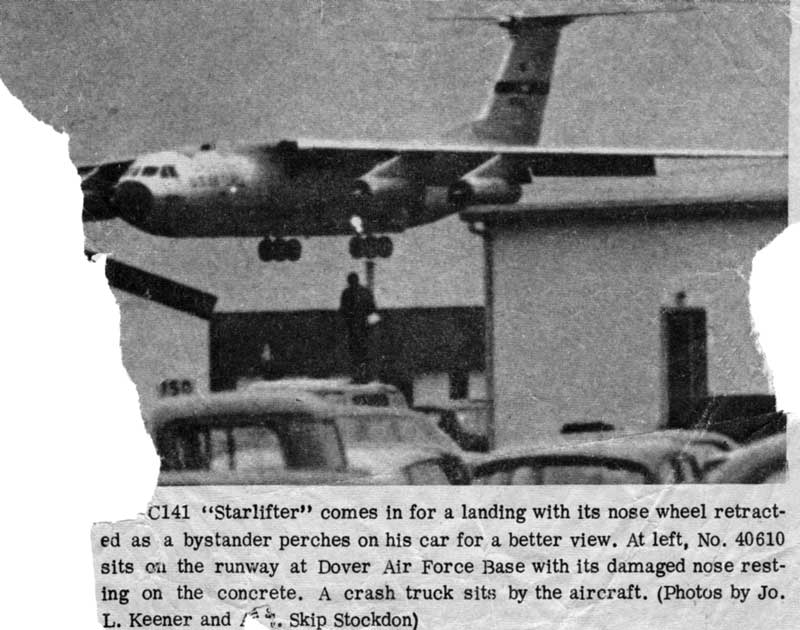
From the caption we can see that there was another photo of the aircraft on
the ramp...but it was missing from the copy she found. She thinks the
incident may have happened between 1968 and 1971 ... her
GRANDFATHER was flying the aircraft.
Anyone with any info about this mishap please
email or contact me . If you
are near Dover you might try making a trip to the public affairs office and
seeing if there are any base newspaper archives going back that far.
Friday, April 10, 2009 11:11 am
Searching for Someone
Does anyone have contact information for COL Tom O'Dell, former commander of
the 97th AS? (McChord AFB, circa late '80's/early '90s). Some old Pilot
Training buddies are trying to contact everyone from the class of 68H at Moody
for a reunion. Anyone who might be able to help should contact
Dave Finch
.
Saturday, April 4, 2009 03:53 pm
C‑141/C‑5 Procedure Trainers...
Back in December Ed Wigfield sent me some pics and newspaper articles about
some C‑141 and C‑5 cockpit procedures trainers he was involved in constructing
out of 'surplus' materials. I promptly scanned all the material and made a web
page about them ... but forgot to post the link for all of you to see.
Click Here
for the photos.
Wednesday, April 1, 2009 11:41 am
Altus
I got the following note from Kyle Disney, who's based at Altus. As more
details and pics of their plans materialize I will update the blog.
Hi All C‑141'ers
I'm Kyle Disney, SMSgt, USAF, current C‑17 Loadmaster and former C‑141B
Loadmaster (5K hours on it.)
Here's the story: here at Altus AFB OK, we had a C‑141 on display at the
flightline . Col Alvin, Wing Commander, has moved it to the parade grounds,
(I will send some of the moving pictures) and it's quite a sight to see!
There will also be a KC‑135 parked there.
Here's the meat: The Boom operator association has a memorial of boomers
who have past away that will be moved to in front of the 135. I have been
asked by my group commander if the Professional Loadmaster Association
(PLA) would like to place a memorial in front of the C‑141.
My association and I would love to put up a memorial, but, unlike the
boomers, I would like to have all C‑141 aircrew members who have lost their
lives on the aircraft. With the help of your site, AF historian, and a
dedicated SSgt Chris Worthy I think we have all of the names.
Now for the begging: My branch of the PLA is small so we can not afford
the whole amount of the memorial, so, may I use your site to get the word
out to solicit funds for this project ? I am waiting on price quotes from
our local granite sellers. I should have a good quote by next week.
Thanks for your time and any help!
Kyle S. Disney, SMSgt, USAF
58 AS/Squadron Superintendent
kyle.disney@altus.af.mil
580‑481‑7163
3/30/2009 6:19:05 PM
New Documentary
My Google news link alert popped this one up today.....
Film shot in war zone brings true stories of army medics and wounded
soldiers to the screen in real‑life M*A*S*H
Available on DVD Memorial Day, May 25
"a film that qualifies as essential viewing when partisan rhetoric and
administration spin too often obscure the war's human cost...Sanders
never
flinches in showing the blood, viscera and immense suffering that too
often
remains on the cutting‑room floor in the journalistic media."
Ann Hornaday, Washington Post
The American Film Foundation announces the U.S. television premiere and DVD
release of the documentary film, Fighting for Life, on Memorial Day, May
25, 2009. The film will begin airing on PBS affiliates nationwide in May,
check local listings. A DIY (Do it Yourself) release, the Fighting for Life
DVD will be available for purchase on the filmmakers website:
www.fightingforlifethemovie.com
.
Fighting for Life by Academy Award‑winning director Terry Sanders (Return
with Honor, Maya Lin: A em Clear Vision) is a powerful and viscerally
affecting documentary portrait of American military medicine. Filmed on the
front lines in Iraq and at U.S. military medical facilities at home and
abroad, Fighting for Life is the story of doctors, nurses and medics
fighting to save the lives of soldiers and marines wounded and maimed in
battle. In this critically‑acclaimed film, Sanders expertly braids three
stories together as he documents military doctors, nurses and medics
working with skill, compassion and dedication amidst the vortex of the Iraq
War; wounded soldiers and marines who face life‑altering injuries with
courage, dignity and determination to survive and to heal; and, the
students of the Uniformed Services University (the "West Point" of military
medicine) on their journey toward becoming career military physicians.
The film also follows the personal story of 21 year‑old Army Specialist
Crystal Davis, on her odyssey from Iraq to Germany to Walter Reed Hospital
in Washington, DC, as she fights to recover from the loss of her leg.
Director Terry Sanders states, "We made a film not only about military
medicine and the unsung healer‑heroes of the Iraq and Afghanistan wars, but
about the courage and spirit it takes to recover from serious injury. We
were privileged to be trusted to share and film the deep emotions of the
military doctors and nurses and to meet many of the wounded, including
Iraqi wounded, to get to know their stories and their feelings, as they
coped, both physically and emotionally with their situations."
Fighting for Life was released theatrically last year to critical acclaim
from some of the most respected publications and film writers in the
country. Matt Zoller Seitz of the New York Times writes of the film, "Shot
in battlefield hospitals in Iraq and rehab centers in the United States,
'Fighting for Life' takes an unflinching look at the physical sacrifices of
soldiers and marines, and the fortitude of the doctors and nurses who treat
them."
John Anderson of Variety writes, "The only people who seem immune to the
politics of the Iraq War are also at its epicenter: the doctors and nurses
who mend and tend to the wounded, and who provide the heart and soul of
Terry Sanders' "Fighting for Life."... What's onscreen is among the most
disturbing footage to come out of the Iraq cinema experience: Sanders and
his crew probe relentlessly with their cameras, never recoiling from the
most horrendous, bone‑revealing injury, or from the long road of pain and
disability ahead for most of the very young people on stretchers, or from
the older but un‑jaded medical teams around them."
The film was shot over a two year period, with a small crew (cameramen Erik
Daarstad and Buddy Squires, soundman Bruce Nolte and co‑producer Jennifer
Glos) led by director, Terry Sanders. Fighting for Life was filmed with HD
cameras in a combat hospital in the center of Iraq, on giant
C‑141 and C‑17 planes outfitted as flying intensive care
units, and in military hospitals in Germany and the United States.
Fighting for Life is presented to PBS stations via Oregon Public
Broadcasting and NETA. Produced and directed by two‑time Academy
Award‑Winning filmmaker Terry Sanders, the film had its nationwide
theatrical debut in 2008 through distributor, Truly Indie. For more
information, please visit
www.fightingforlifethemovie.com
Monday, March 30, 2009 06:09 pm
C‑141 BBQ ... Really!
Rich Lloyd just sent me this link :
Smokin' Starlifters
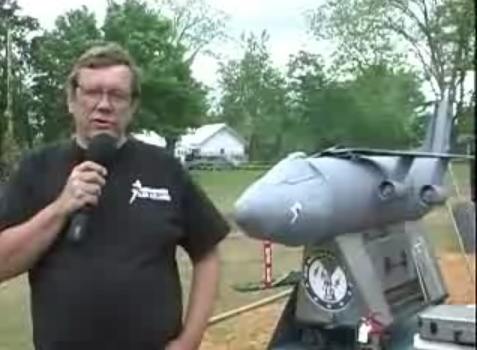
Just like in real‑life, it looks like the wings are about to fall off. It
even has a 'remove before flight' streamer.
I wonder if anyone knows where this thing is today?
Sunday, March 29, 2009 04:39 pm
New Pictures
Got a little packet of photos from Joe Meyer of New Braunfels, Texas, this
week. At first I was not sure what had survived the post office machines.
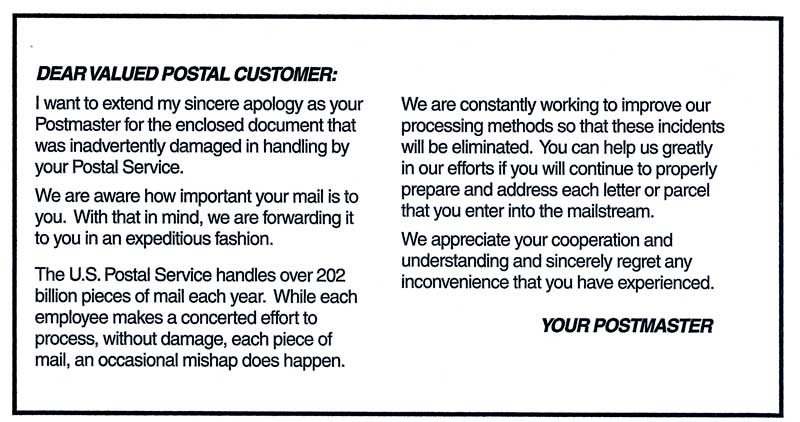
The Apology.
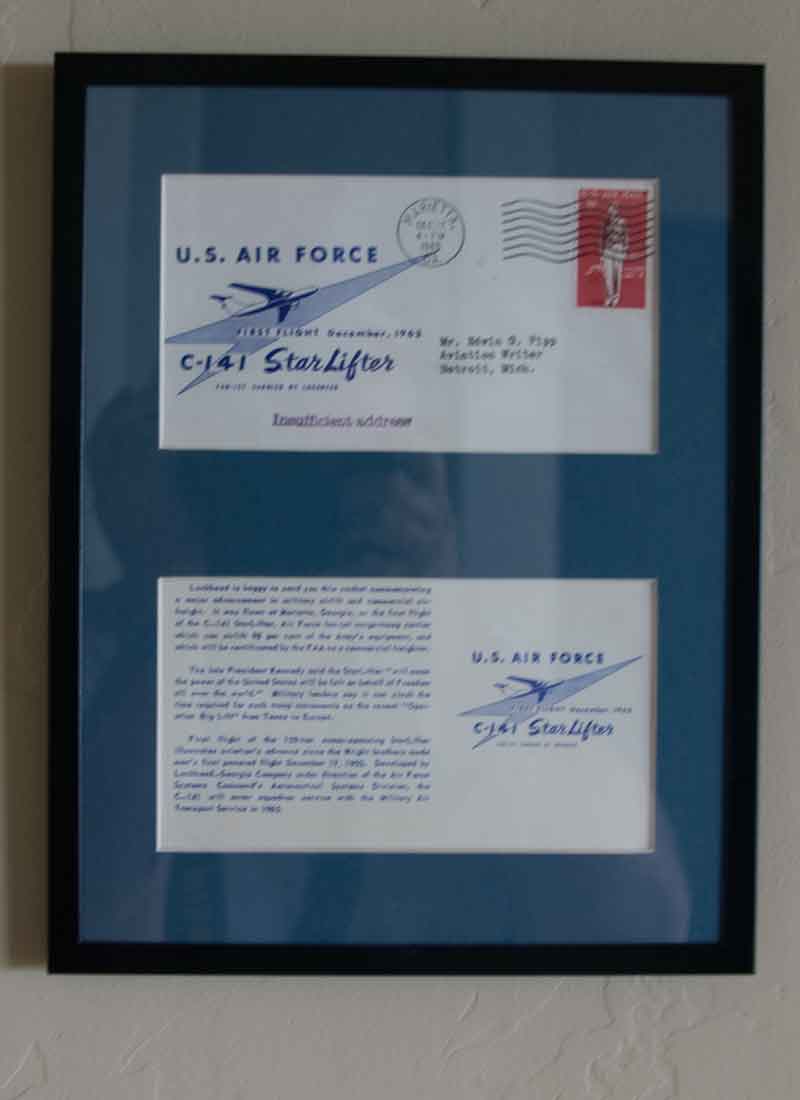
The Contents
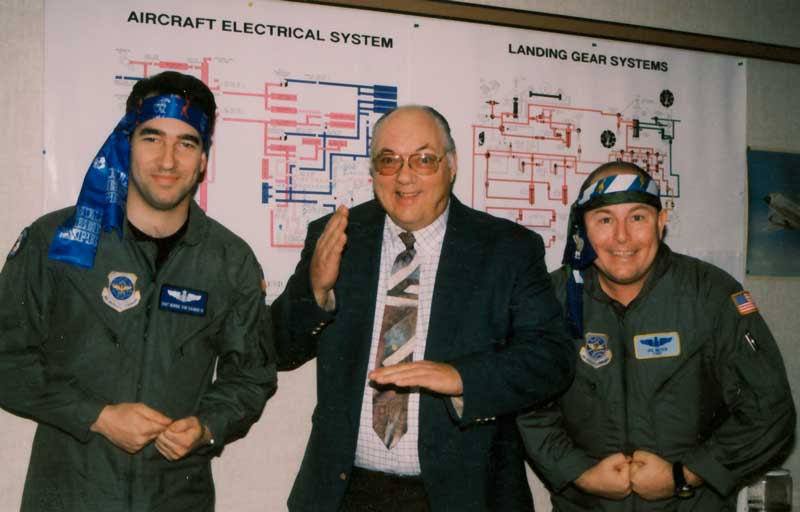
The last C‑141 INSTRUCTOR FLIGHT ENGINEERS. Joe is on the right.
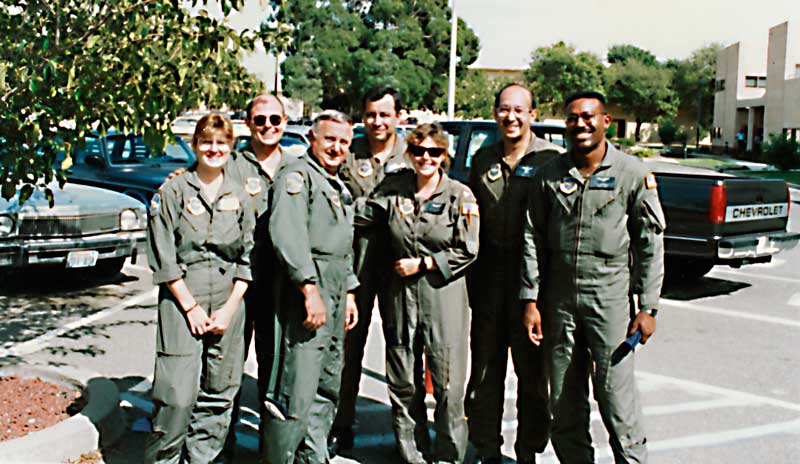
A Travis 710th crew after a trip around the Pacific rim.
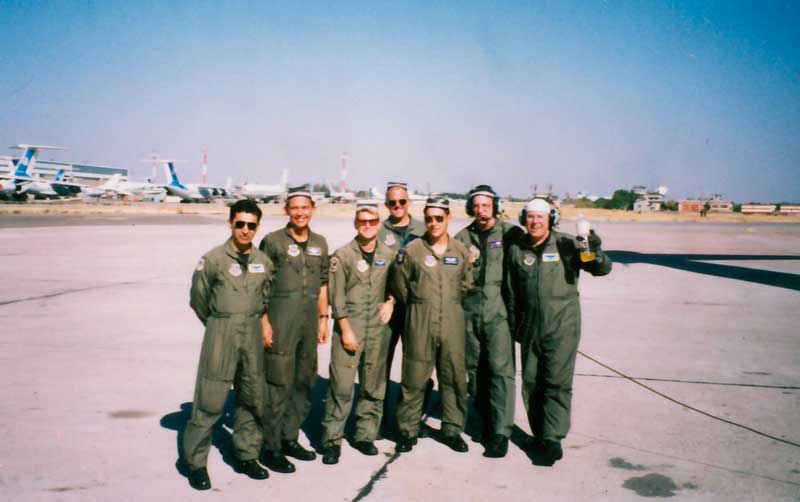
Uzbekistan .. a 30‑day TDY for med evac duty, approx 1977.
The Russian IL‑76's in the background are all scrap,
their version of the Boneyard in Tucson.
The crew is a combined Bully Beef and 702 AS crew.
LtCol Kim Mortenson (2nd from left) met his future wife
there and moved her to the states...married happily ever after.
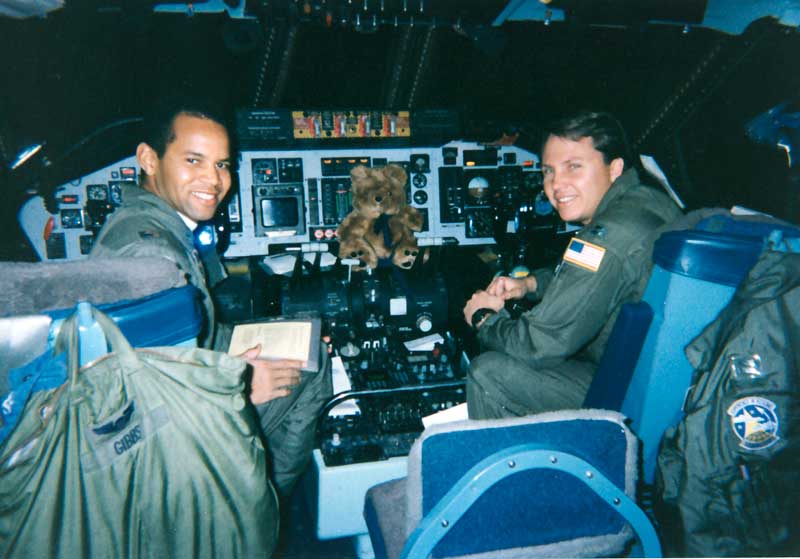
Captain's Gibbs and Digman, 710th AS, Travis AFB, 1996.
The crew carried the teddy bear around the world and returned
it to a first grade class in Indiana, its backpack full of disposable
cameras and trinkets....
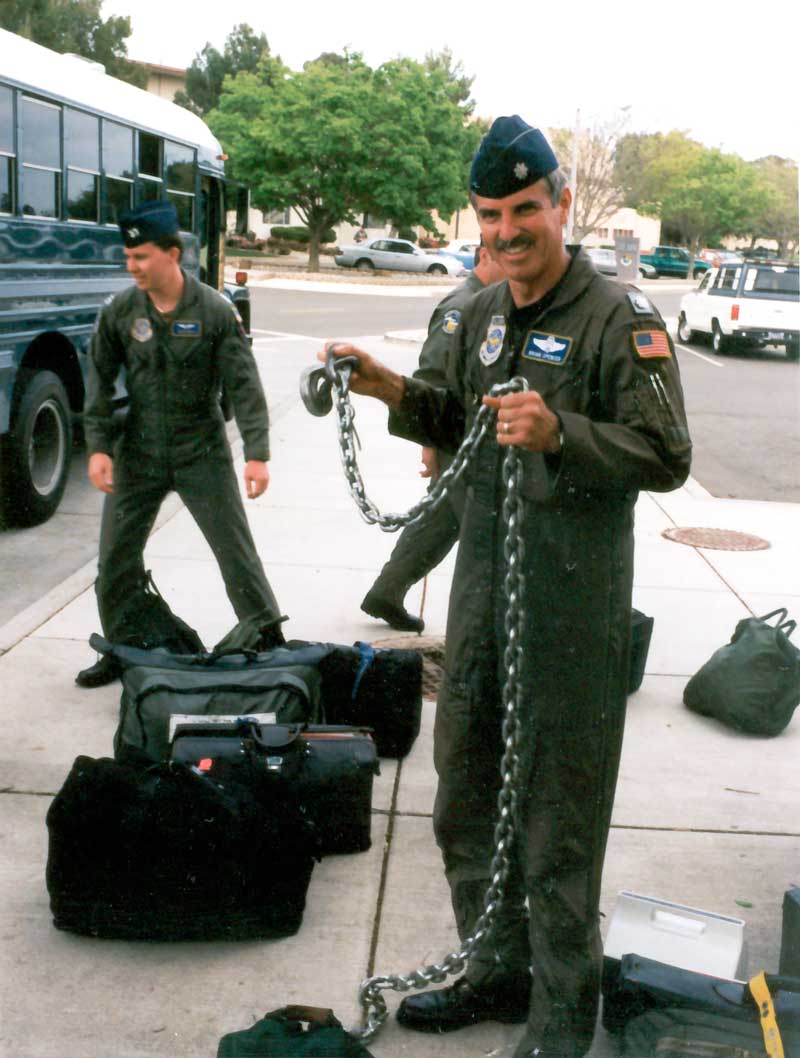
Special luggage treat for (then) LTC Brian Spencer's fini-flight, 710th AS,
1996.
A few more pics of him follow.
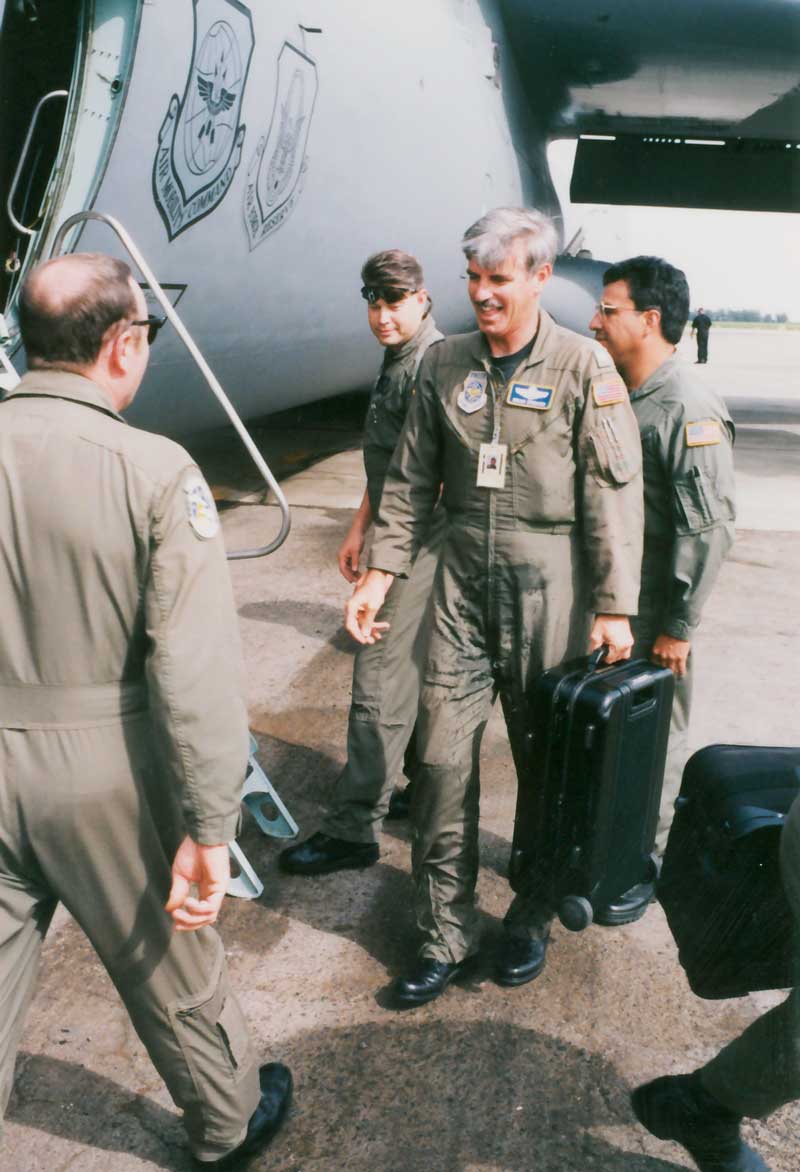
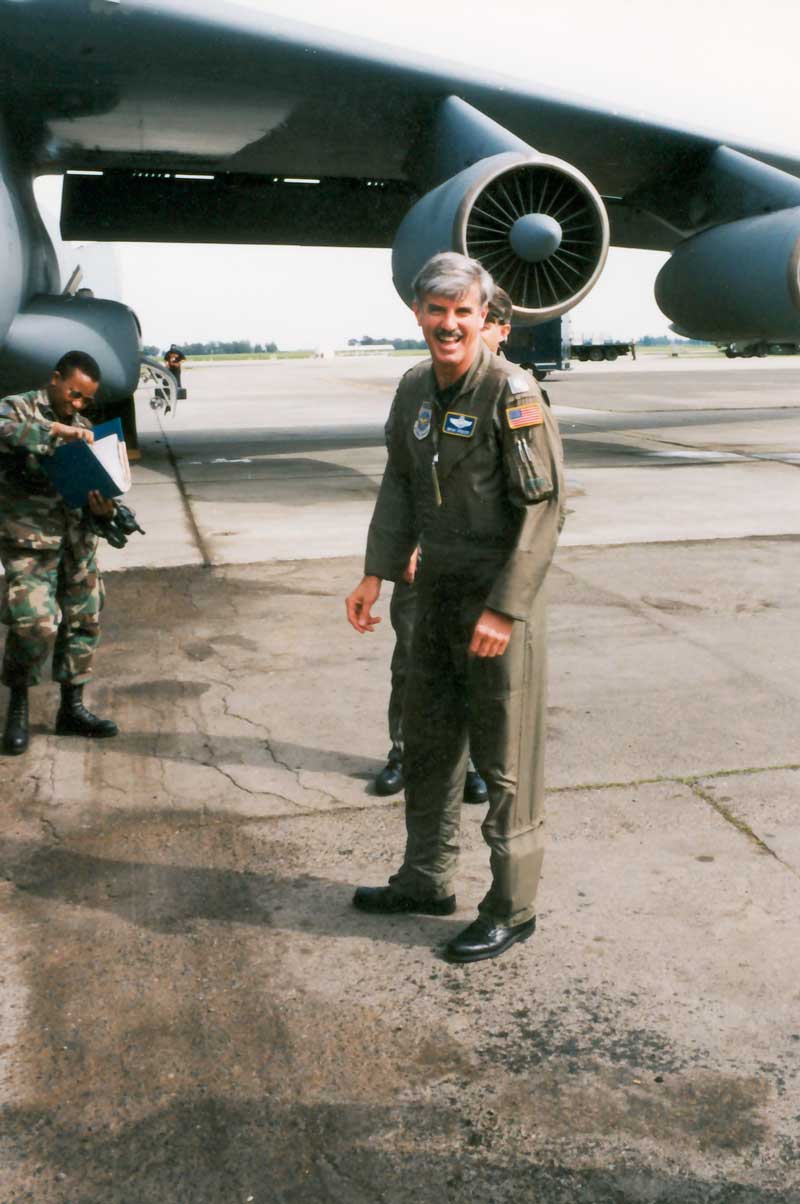
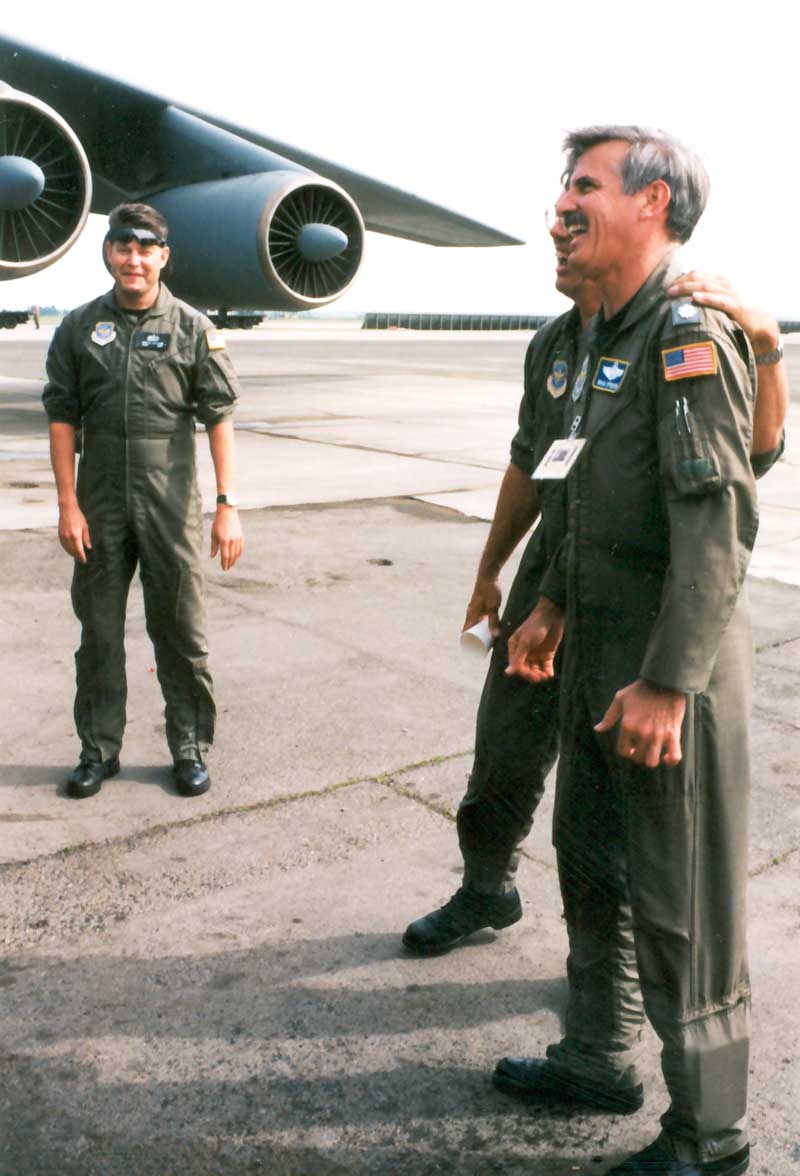
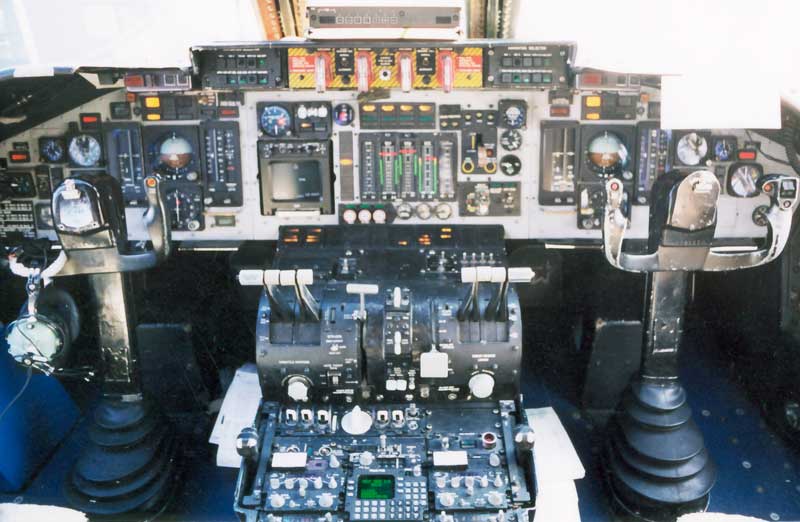
Nice Cockpit shot.
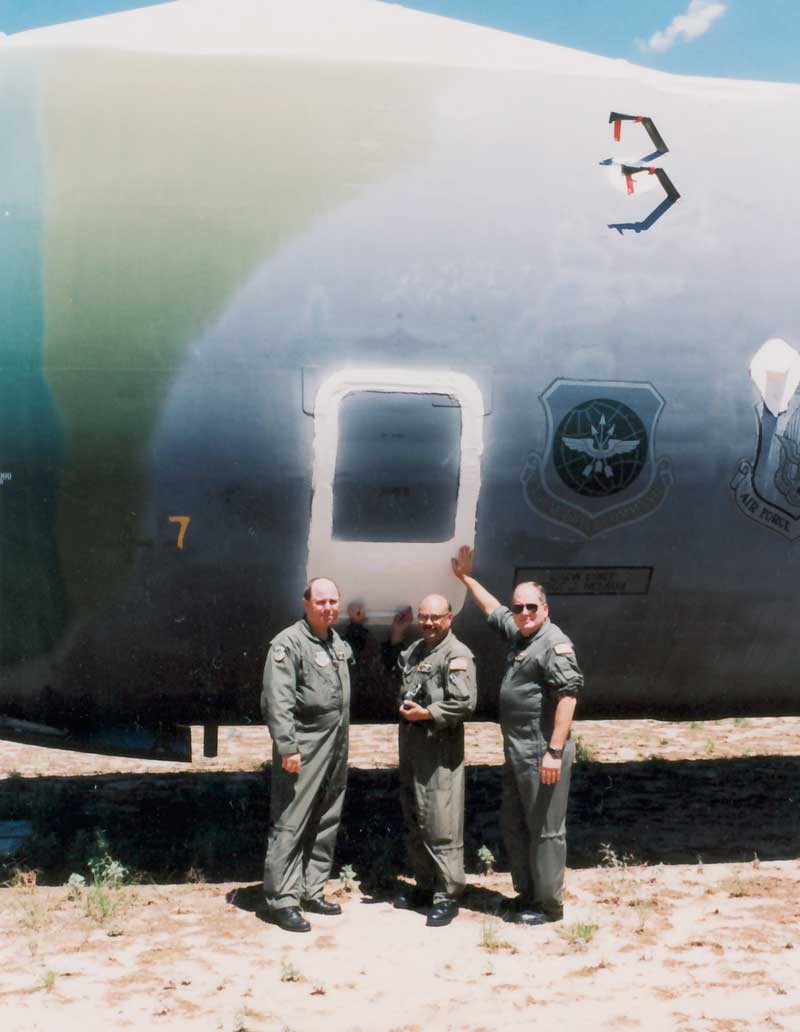
TSGT Joe Meyer, Smsgt Lous Pacheco, and TSGT Page Van Atta put 9404 to bed
at the DM Boneyard in 1998.
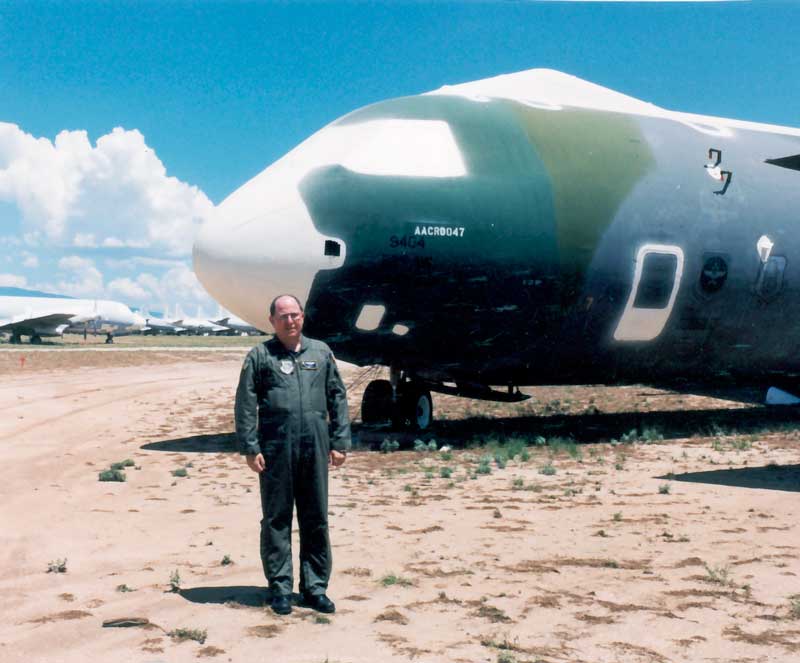
Monday, March 23, 2009 05:44 pm
The Way Back Machine
David Kutulis, Sr. CMSGT(RET) sent in a few pics of the good old days when
the C‑141s were silver. The pictures follow his note:
3/16/09
My brother, knowing that I had once worked on C‑141s, hooked me up with
C141Heaven the other day. I have spent the last few nights going thru the site
and am amazed at what you have done.
I was assigned to the 63rd MAW in May of 1967 when there were only six
aircraft assigned. I spent the first four months working the Phase Dock but
having crewed B‑47s and EC‑135Ps (CICPAC Airborne Command Post) I found
that I really missed the flight line. After about four months I moved to
the flight line and waited my turn for a newly arrived aircraft.
One day the Line Chief showed me a list of the tail numbers that would be
the next batch of planes to arrive. I had my choice of 70005, 70007, 70009
or 70011.
Seven‑Eleven sounded good so I chose it. When it arrived in, October of 67
, it had 6.5 hours on it. It was, I'm told, the first one on the west coast
with the auto landing system and was not authorized at the time to be used
in the system.
The next month and a half it spent its time on training flights to Palmdale
(Plant 42) and Edwards AFB. It flew twice a day almost every day. The MAC
commander at the time had a flight in it.
The last week of November the aircraft scheduler told me they now could put
the aircraft into the system and asked if I wanted a day off. I never saw the
bird during December. When it returned to Norton it was at night and the
ACC turned it.
I read on one of your posts about Pachinko balls, 70011 had its share as
well as dog food. It went to Kelly to pick up a load and when it came
through Norton I climbed in the plane to open the right rear troop door to
refuel it and ran into nine pallets of dogs bound for the war zone. They
were not happy campers. Months later we were still finding dog food in the
floor area.
I crewed 70011 into 1969 when I was selected to be the Crew Chief on the
aircraft that was to participate in the first MAC Airlift Competition.
After that, I was shuttled off to be a Quality Control Inspector. After I
transferred from Norton I never saw 70011 again and often wondered what
happened to it .... now I know. I guess it saw its share of history with
its classified mission to the Falkland Islands and having the call sign Air
Force One. I have been to Australia, New Zealand, Argentine, Europe and the
Mid East in the 141 both as part of the crew and as a passenger and I always
enjoyed my time in it.
Every few months when I drive by March Field I look over at the C‑141 in
the museum and reminisce, once I stopped to check it out and found some
outfit was holding a birthday party in it and access was restricted. I
ignored the sign and toured the plane, standing in the cockpit I was amazed
at how small it seemed to be after so many years.
Loved to bug the FEs with the joke about the monkey and parrot, the monkey flipping
the switch, and the parrot saying check complete.
Here are a few pictures you may want to use. Three of them are of the
personnel who made up the 63rd Air Lift Competition Team and one of myself
and the crew chief of 005.
I'm not sure if it's 005 or 011 we are standing by since I took care of 005
for two weeks while the other guy was still in FTD School.
I have another picture I think you would like. If you remember the AF
Safety Office put out a monthly magazine and in it, there was a section
concerning: maintenance. Guys could write in questions about maintenance
policy practices and they were answered by a blond gal named Toots.
Somewhere I have a picture of her standing on the tail of 0011. If I find
it I'll send it also if you need 8x10's of the ones I sent I'll get some
made.
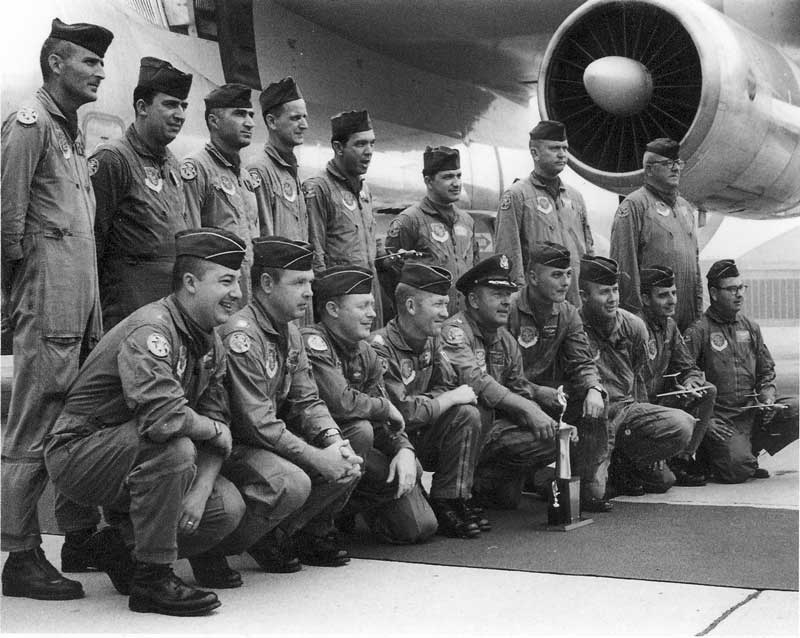
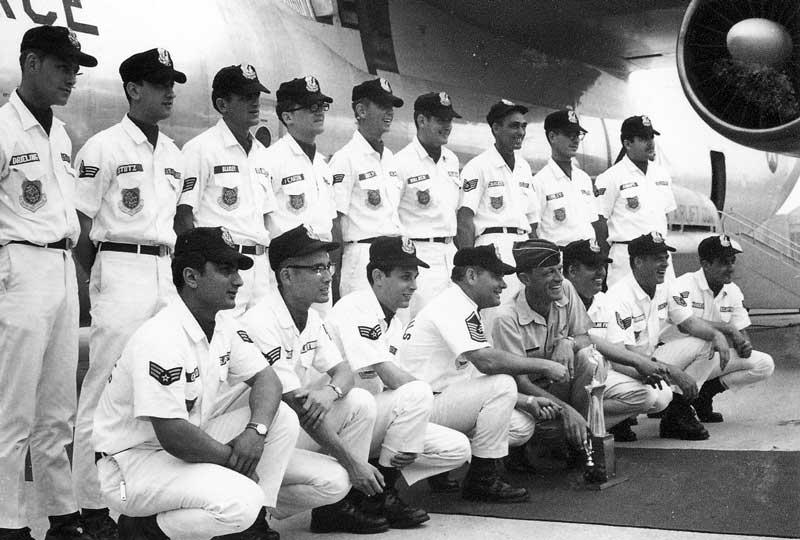
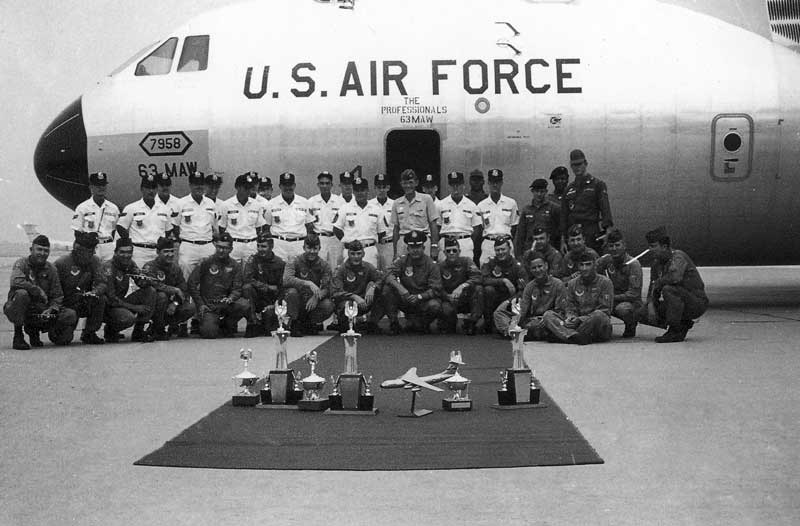
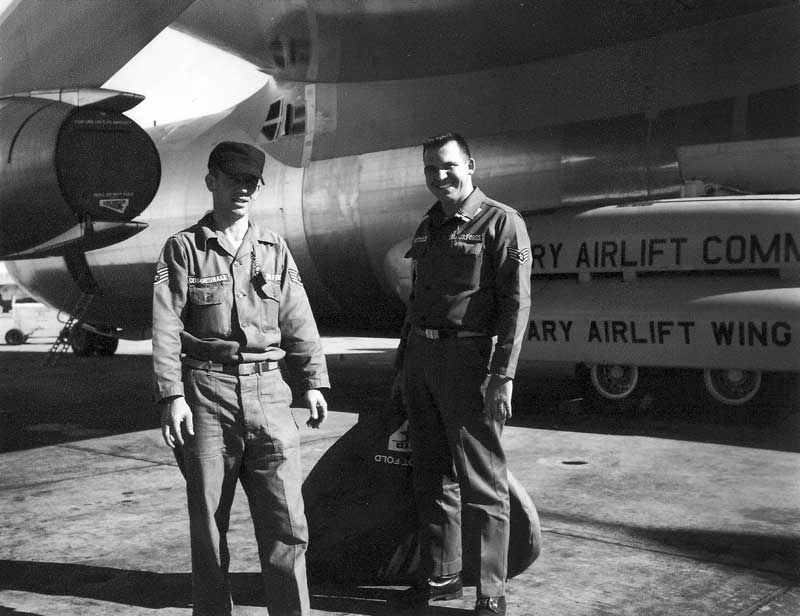
That's me on the right!
David Kutulis, Sr.
CMSGT (RET) Lancaster CA
davekutulis@hotmail.com
Monday, March 2, 2009 05:15 pm
Smoke and Flames ‑ The Crash of 67‑0008
Leon Larson sent in some pics of the immediate aftermath of the crash of
67‑0008 at Sondrestrom, Greenland in late August, 1976.
click
here,
(and scroll towards the bottom of the page...)
.
Sunday, March 1, 2009 05:11 pm
First Hand Account of the crash of 66‑0150
Some US Army Rangers were on the ground near the location of the crash of 66‑0150
in February 1989. To read a very detailed first hand account of the story,
click here,
(and scroll towards the
bottom of the page...)
. (Note:You may need to press F5 to refresh your
browser display.)
Sunday, March 1, 2009 04:08 pm
"Pilot to Alligator"
Got this not from Emily Blalock from Albany, Georgia:
In 1967 during the 7 day war in Israel I needed to take my young son to
Germany to the hospital and since Egypt wouldn't allow our planes in their
airspace the medivac plane (I believe it was a C‑54) couldn't get to Kagnew
Station in what was then Ethiopia to pick us up.
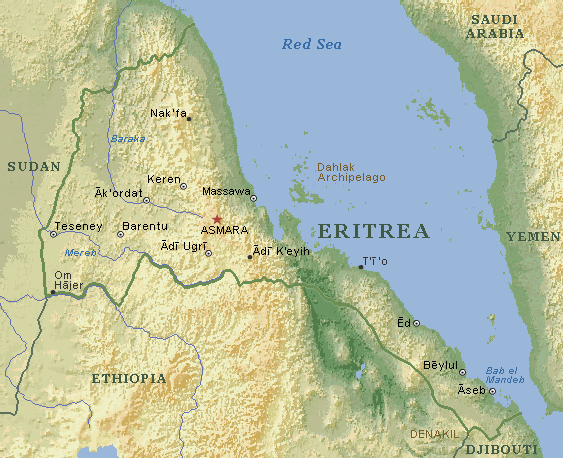
A C‑141 from Charleston, SC flew into to Asmara and we were then taken
to
Adana, Turkey, and on to Weisbaden, Germany. I was pregnant with my
second
child and the crew was so good to me and my son. We sat in the cockpit
where they let Fred wear a head-set.
Just over Addis Ababa he asked me, "Mama, when is he going to say
'Pilot to
Alligator' like they do on TV?"
Everyone just roared with laughter. He was referring to the only TV
program
that we got in Asmara: "12:00 O'Clock High" and the reference to the
alligator was 'navigator'.
Emily Blalock
For those of you (like me) who never heard of Kagnew Station (a US military
listening post) you can learn more at
this link
and also at
Wikipedia
.
Monday, January 26, 2009 05:19 pm
Hudson River ... US Airways .... Terrorists Found!!!
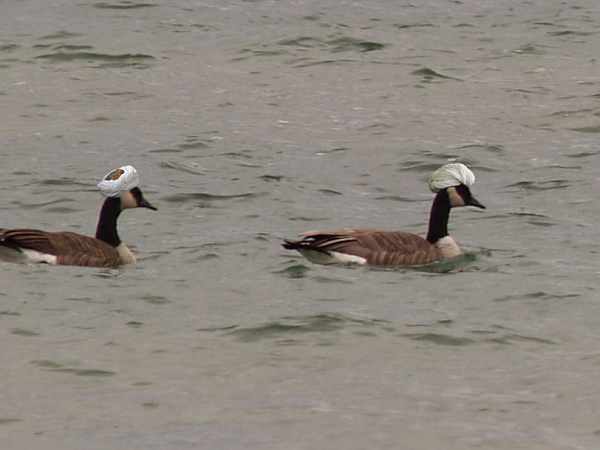
Saturday, January 24, 2009 04:42 pm
Do you remember PACHINKO's?
I got this note from John Englar, whose father used to bring PACHINKO machines
back to McChord from Japan:
Here's one of my dad's USAF stories.
We were stationed at McChord. I remember my dad coming home from one of his
many overseas flights with a Pachinko machine.
This was 1969 -1971, I just don't recall the exact year as kid. If anyone
remembers the 60s-70s, they were all the rage.
You could pick them up cheap in Japan. Dad took 'orders' from other base
personnel and would bring back several of these machines at a time. He also
purchased bags of extra balls for each machine. Each bag had 500 Pachinko
balls.
They loaded them all in the Starlifter for the return flight and somewhere
over the pacific one of these bags fell, broke open and scattered 500
Pachinko balls all over the cargo hold. He said that they never did find
them
all!
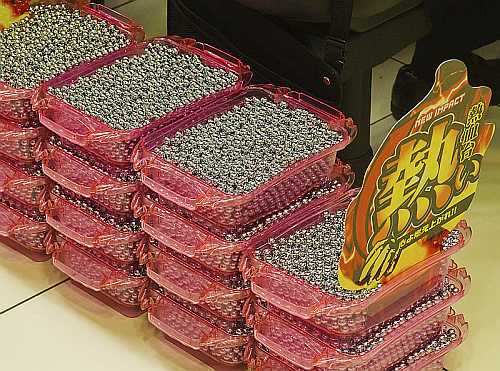
Piles of Pachinko Balls
Over the years dad mentioned that there was a 141 flying around
somewhere
with Pachinko balls rolling around cargo hold and we all can't help
but
chuckle about it.
So if there is ground maintenance personnel, or maybe the guys at
Lockheed
that stretched this particular bird (he doesn't remember the tail
number),
that found ball bearing like steel balls with Japanese writing stamped
on
them, now you know what they are and how and when they got there!
Here's a picture of my machine that still keeps all the kids
entertained.
It's a bit worn from all the moves, some of the balls are pitted and
not as
shiny, but it still works.
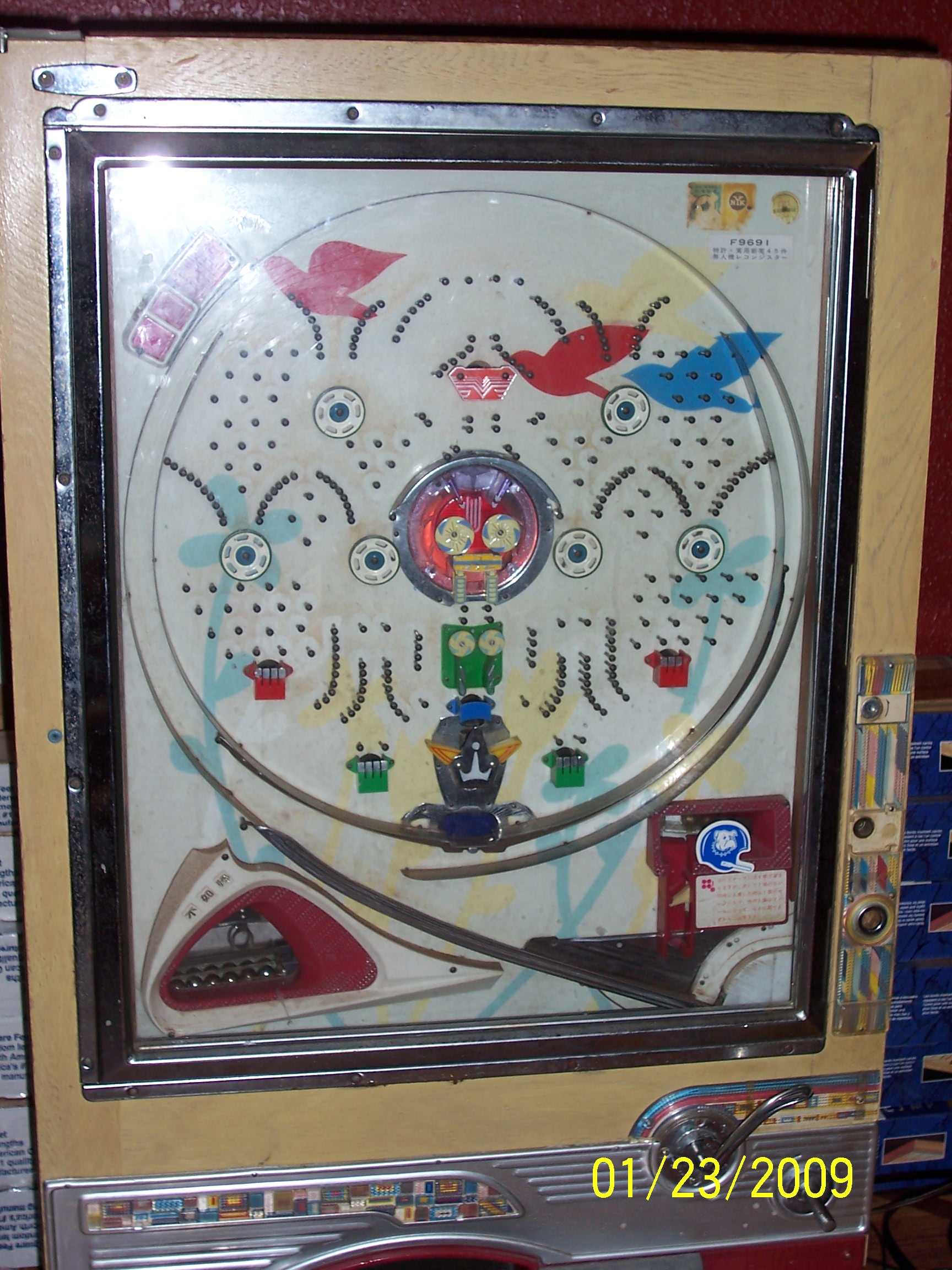 I wonder if anyone else still has there machine from that flight
I wonder if anyone else still has there machine from that flight
Jeff Englar
Click here for More on Pachinko
I don't know if the guys from Travis and Norton were as in to Pachinko machines
as the guys at McChord, but you are 100% right about the McChord people ... they
were nuts about the damn things.
Depending on condition and your ability to haggle, the machines went for $10 to
$25 dollars. I brought back several for friends in the mid-'70s.
My parents lived in San Diego when I was stationed at McChord. One day we had a
series of special missions flying a bunch of folks from Fort Lewis to Navy North
Island. I made two round-trips from McChord to San Diego that day. On the first
one we had a very fast turn- around planned. After the troops and cargo were
off-loaded I found a guy driving around somewhat aimlessly in a truck on the
flight-line. I flagged him over and handed him a Pachinko machine and told him to
go in to base ops and shout out my dad's name. He was supposed to be waiting
there for it. I know it made it safely to his hands as I saw it at their house
years later when visiting for the holidays.
There were Pachinko parlors in Japan ... with hundreds of machines ... not unlike
a Vegas casino. I've never figured out the attraction .. but like the slots ...
Pachinkos are noisy and mindless. It is probably a good break from whatever
doldrums you suffer through at work.
Another big "goody wagon" (AKA: The C‑141) item was those big green Kamado Pots
(also referred to frequently and incorrectly as Hibachi pots).
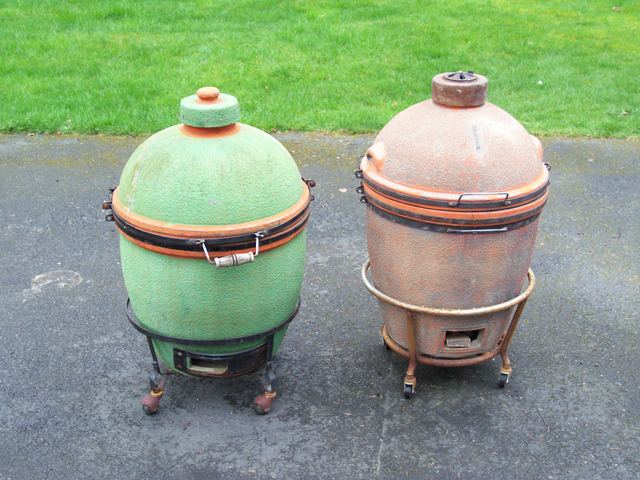
More than a few ended up in pieces on the flight-line or in the back of a C‑141
... and if you did get them home unbroken and fired them up they pretty much
became very brittle and nearly impossible to move successfully. Today, there are
American-made versions selling for about $700 .... nice glazed
ceramic ones that don't crack with use. As I recall, we paid about $25-30 (the $
was em against the Yen back then!) for the clay ones, and once you brought
one home for your patio...all the next door neighbors would say "I was thinking
.... since you're going over there anyway ....". You know the rest of that line
of thinking.
Saturday, January 24, 2009 04:38 pm
No More Shirts ...
Late last year I posted a note about some C‑141 shirts that one of C141Heaven's
visitors
had started to sell on eBay and directly via mail. I bought one and they were very nicely
done. He got good reviews from other folks that bought them, but he's had some trouble
getting folks to pay for custom embroidered ones and has decided to stop selling them
because of the hassles.



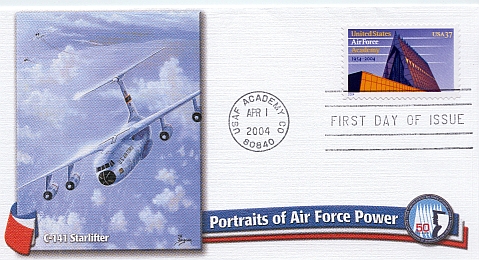




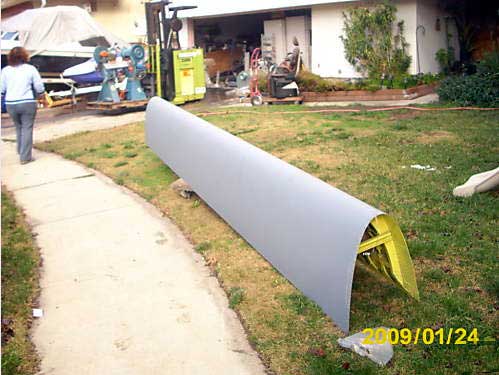
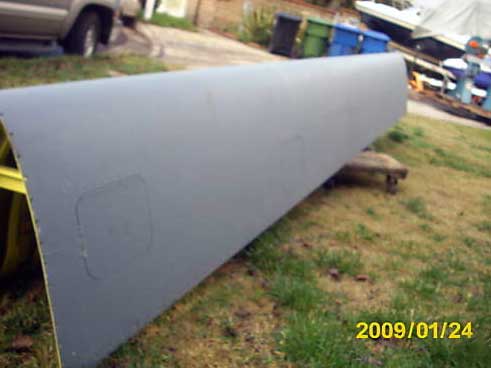
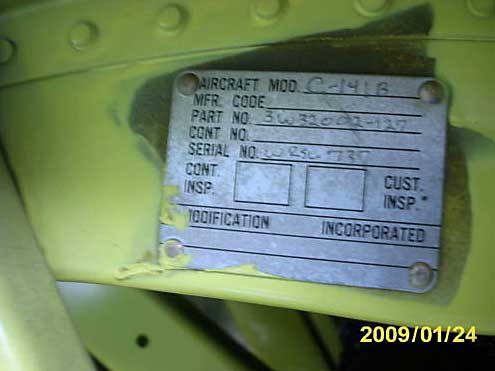
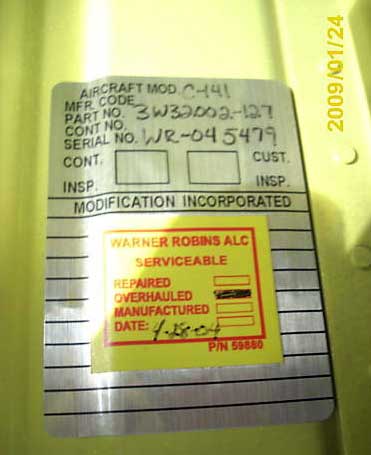
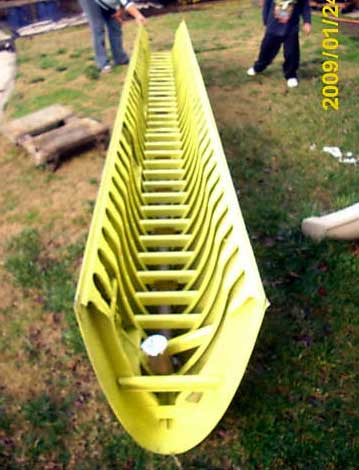
















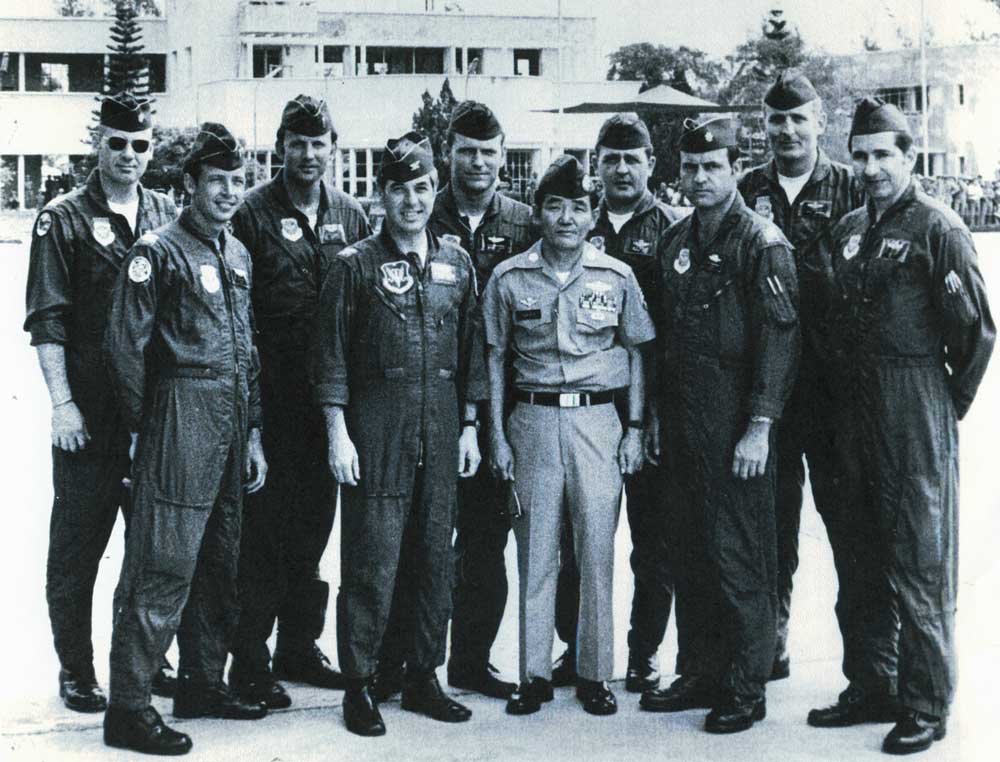
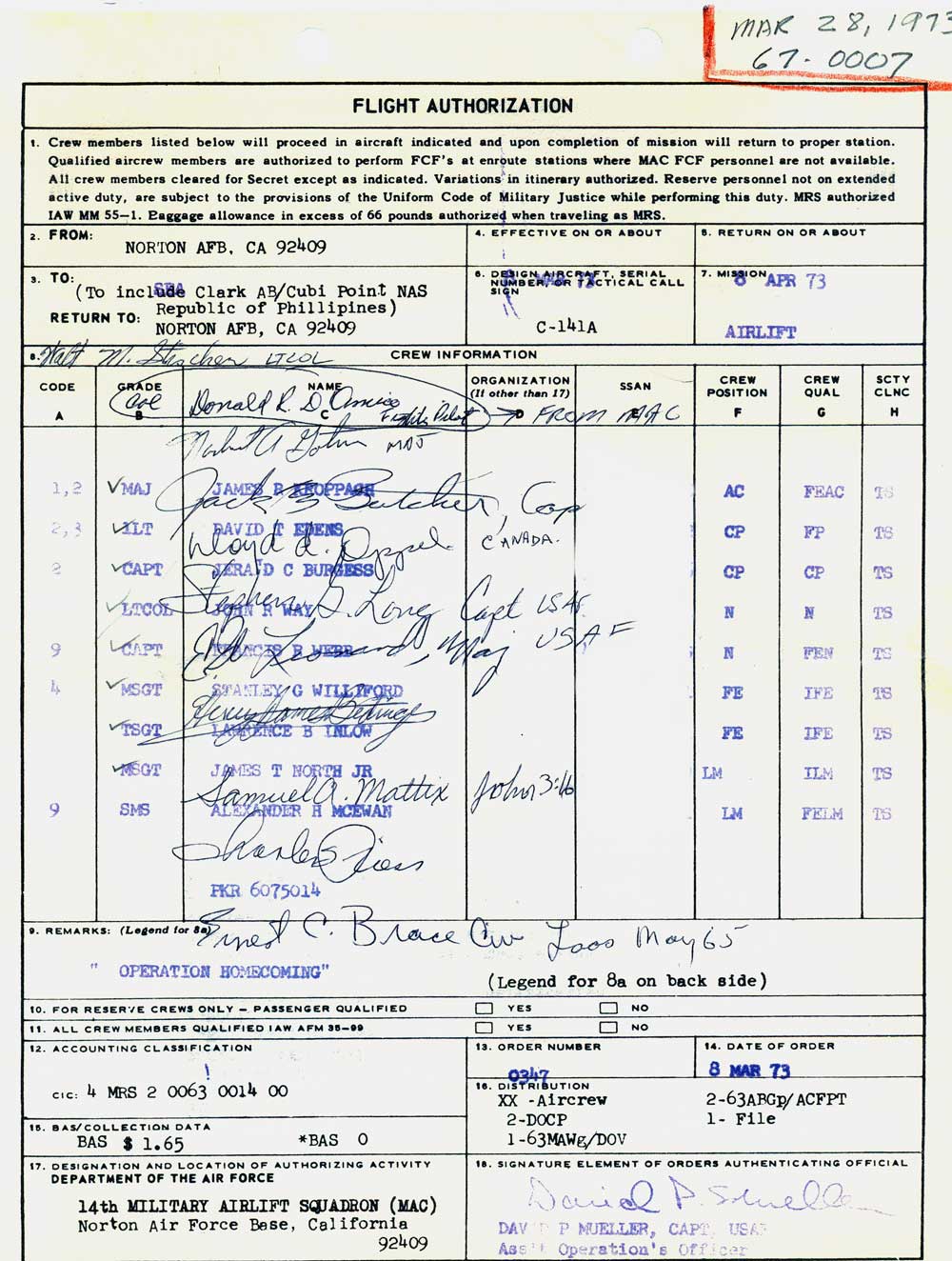
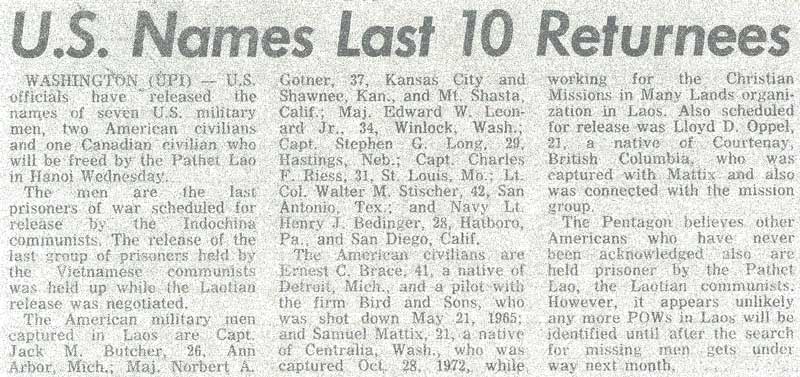
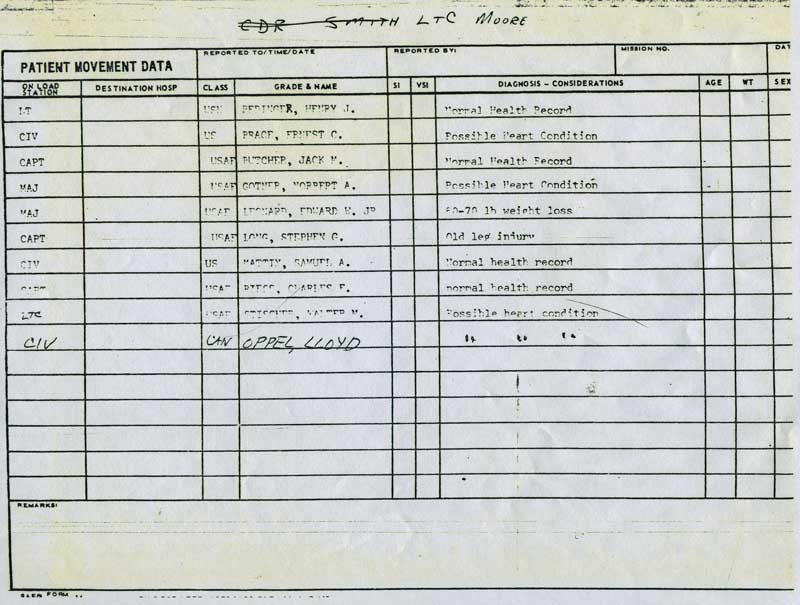




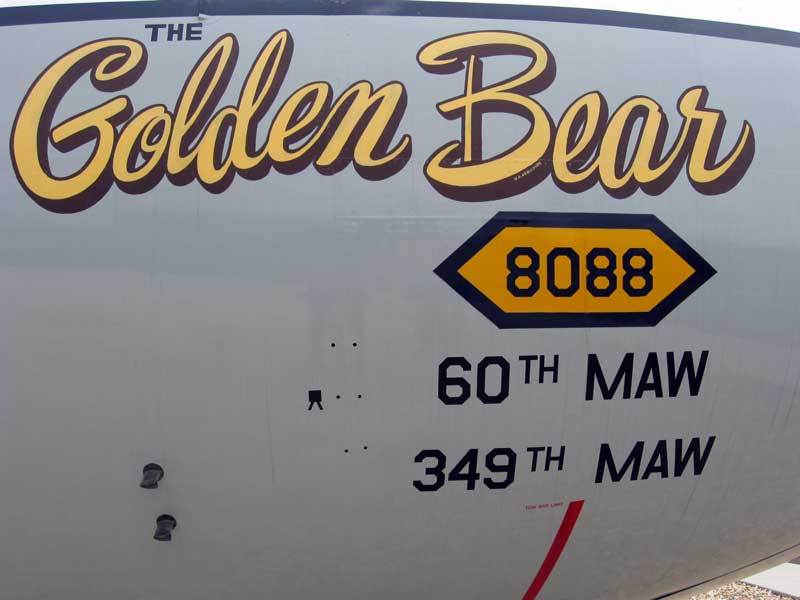
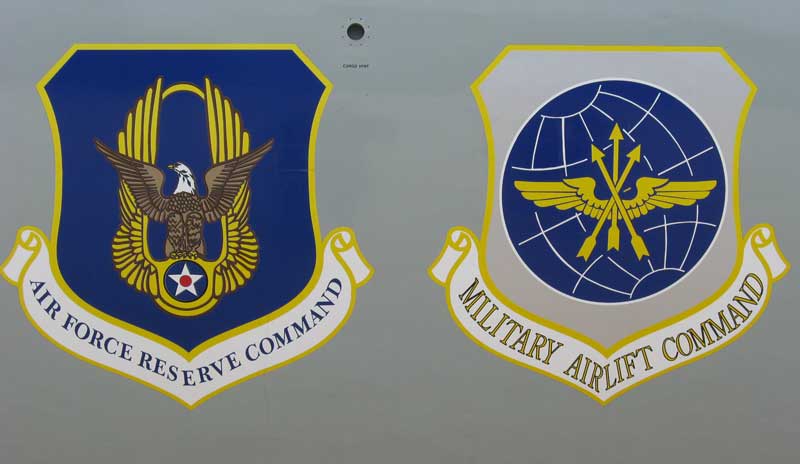
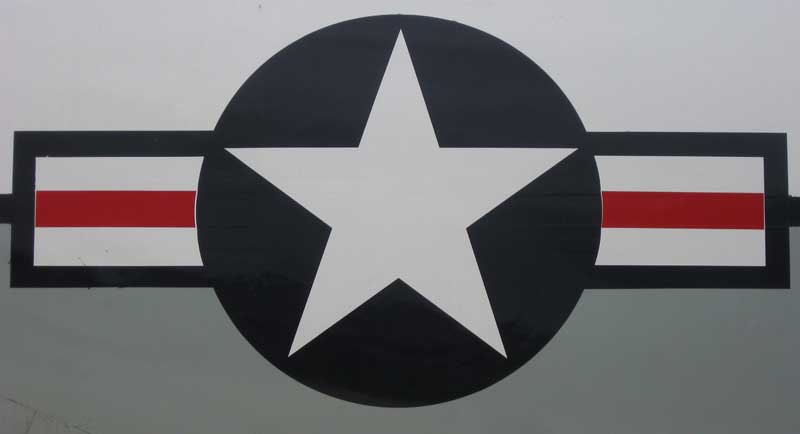
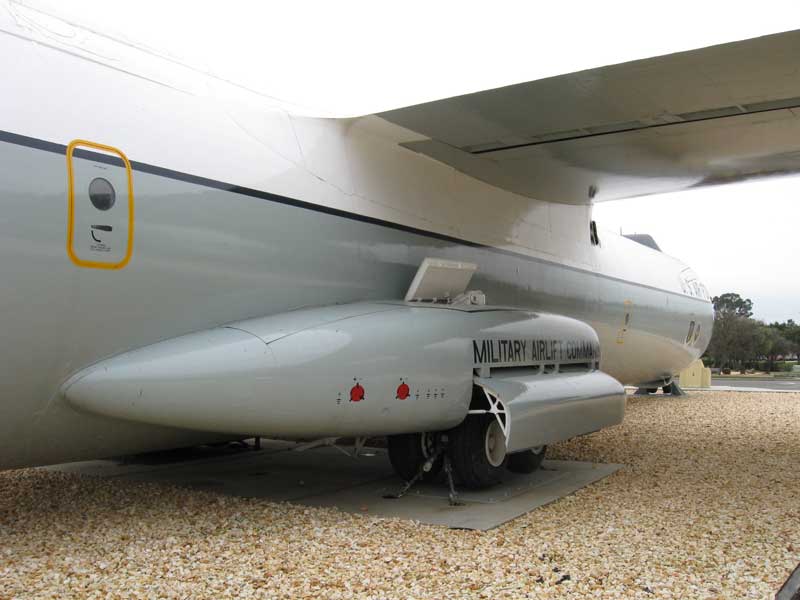
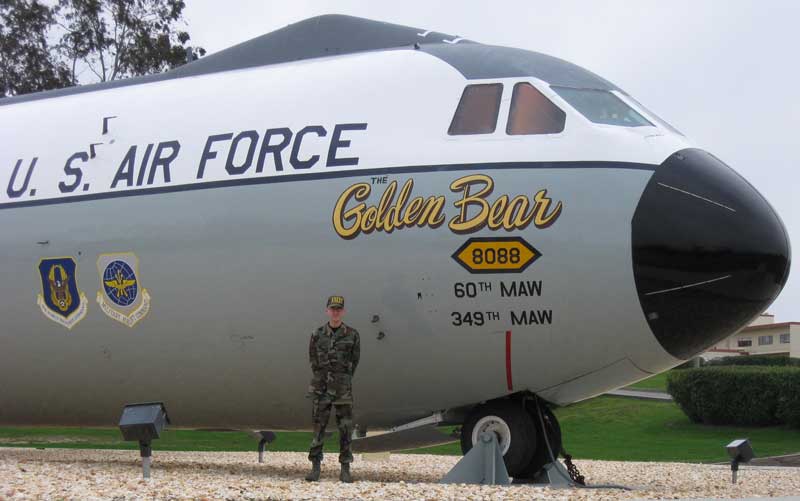
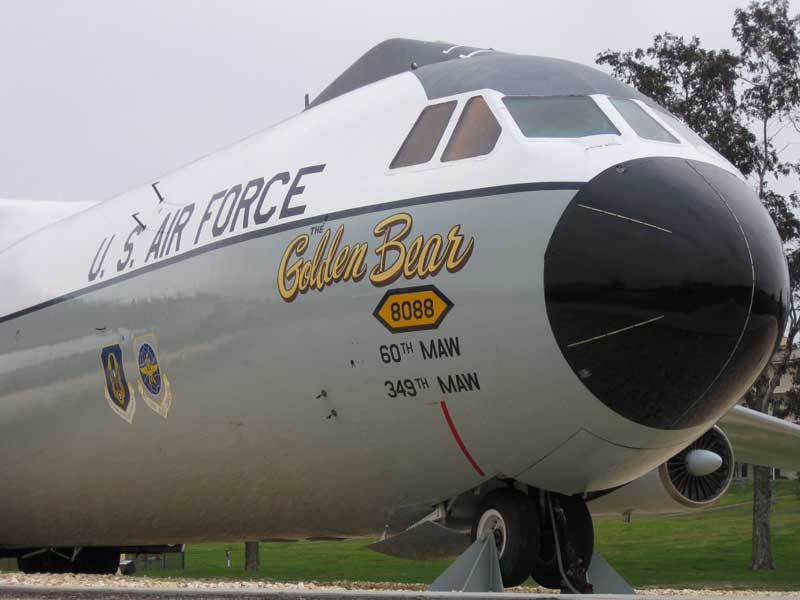
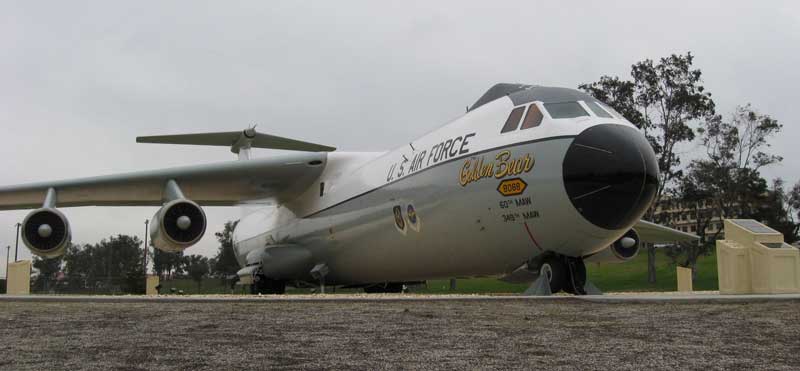
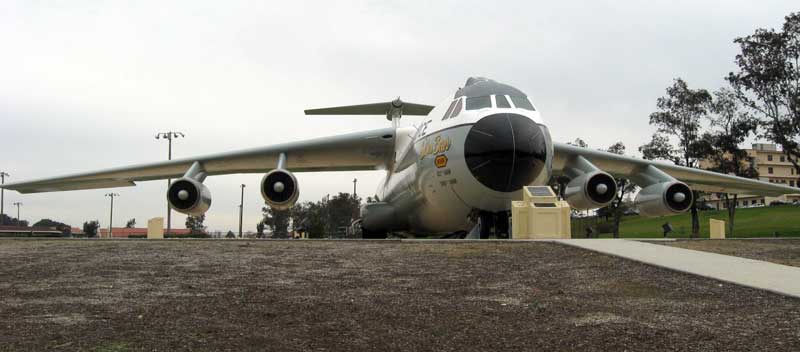
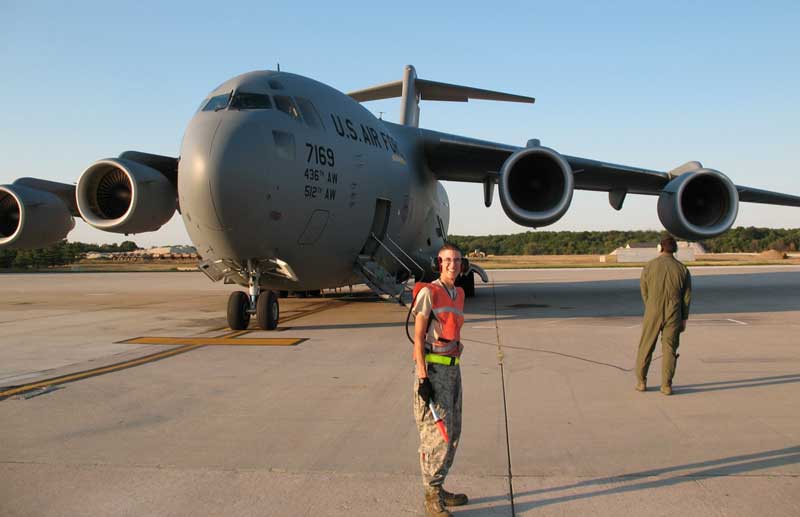



 I wonder if anyone else still has there machine from that flight
I wonder if anyone else still has there machine from that flight
